Systematic Review of Satellite-Based Earth Observation Applications for Wildlife Ecology Research in Terrestrial Polar and Mountain Regions
Abstract
1. Introduction
1.1. Relevance of Wildlife Ecology Research in Polar and Mountain Regions
1.2. Relevance of EO for Wildlife Ecology Research
1.3. Objective and Structure of This Review
2. Materials and Methods
- Method groups: landcover classification, habitat modelling, correlation analysis, change detection, manual animal detection, movement analysis, automated animal detection, trend analysis and object-based image-analysis.
- Research objective groups: distribution, foraging, landcover change, reproduction, movement and insect outbreak.
- Environmental data groups: vegetation cover, snow cover, ice cover, single animals, guano, forest, land cover and land use, and multi-environmental data studies.
3. Results
3.1. Quantitative Analysis of Publication Meta Data
3.1.1. Development of Research Interest over Time
3.1.2. Spatial Analysis of First Author Countries
3.2. Spatial Analysis of Studied Countries and Study Locations
3.3. Studied Animal Species
3.4. Satellite Based EO Sensors and Sensor Types
3.5. Spatial Scale
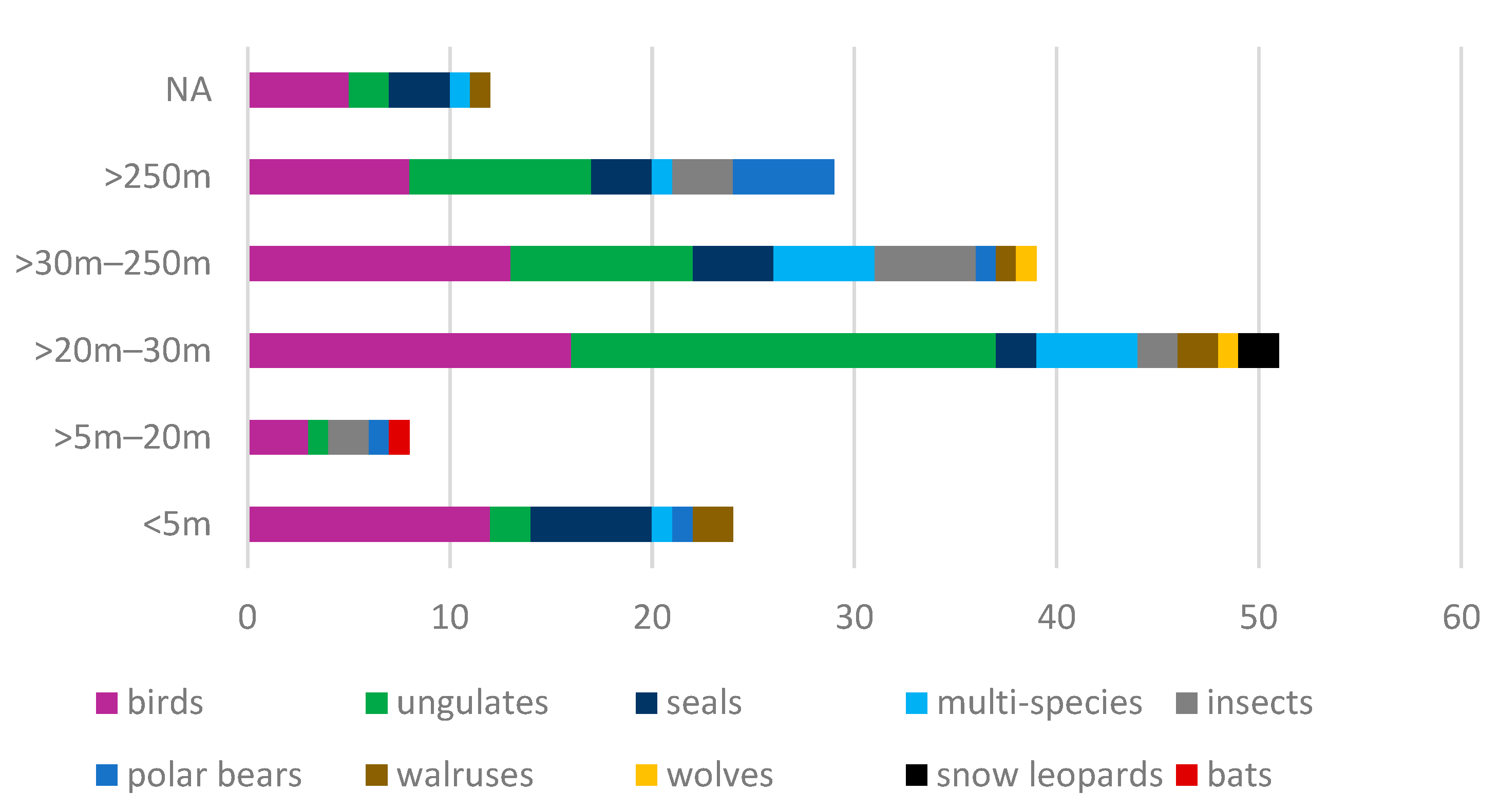
3.6. Temporal Resolutions of EO Data
3.7. Methods Used
3.8. Use of UAV Data in Addition to Satellite-Based EO Data
3.9. Thematic Review of Study Foci
3.9.1. General Thematic Review of Study Foci
3.9.2. Sensor and Sensor Type Specific Review of Study Foci
3.9.3. Animal Specific Review of Study Foci
3.10. Evaluation of the Impacts of Environmental Changes
4. Discussion
4.1. Main Findings After Reviewing 145 Studies
4.2. Limitations and Benefits of Using EO for Wildlife Ecology Research
4.3. Future Perspectives
5. Conclusions
- Interest in EO data for wildlife ecology research in polar and mountain regions increased from one publication in 2000 to a maximum of 12 publications in 2016 and 2021. On a country level, the majority of studies are located in Canada (43 studies) and the Antarctic (40 studies). Regionally, study locations are dominated by the Antarctic peninsula, Nunavut in Canada, Svalbard in Europe, and Alaska as part of the USA. Most of the authors are affiliated with the USA (48 studies) and Canada (37 studies).
- Bird (52 studies) and ungulate species (38 studies) are the main animal groups and are dominated by penguin species (25 studies) and reindeers (29 studies), respectively.
- A total of 130 studies used multispectral data, while only 15 studies used SAR data. The majority of studies applied Landsat data (63 studies) and MODIS data (52 studies). This aligns with the findings that spatial resolutions of 20 m–30 m were used for 44 studies and resolutions of 30 m–250 m were used for 31 studies. Despite long-running satellites (e.g., Landsat and MODIS) and the majority of the studies being multi-temporal (66 studies) and time series analysis (51 studies), there is no increase in study length.
- Environmental EO datasets were most frequently accessed for vegetation (32 studies), ice (29 studies), and snow (19 studies). Research focused mainly on distribution mapping (64 studies) and foraging area analyses (26 studies). Landcover classification and (41 studies) and habitat modelling (29 studies) are the methods applied most of the time.
- Major challenges of interdisciplinary work include the promotion of unused opportunities and expanding study areas to eastern regions. The potential of available Sentinel-1, and -2 data, new sensors like CHIME, and AI concepts are not fully realized.
- Choosing an EO dataset that fits in spatial and temporal resolution seems to be challenging in the wildlife ecology community. Interdisciplinary working groups should be encouraged.
- Rapid changes in climate and landscapes require efficient, continuous monitoring of environments and their inhabitants. Near real-time data collection and connection to animal species data should be discussed for short-time management planning and climate change related adaptations.
Supplementary Materials
Author Contributions
Funding
Data Availability Statement
Acknowledgments
Conflicts of Interest
Appendix A. List of Keywords for Web of Science Search String and List of Journals
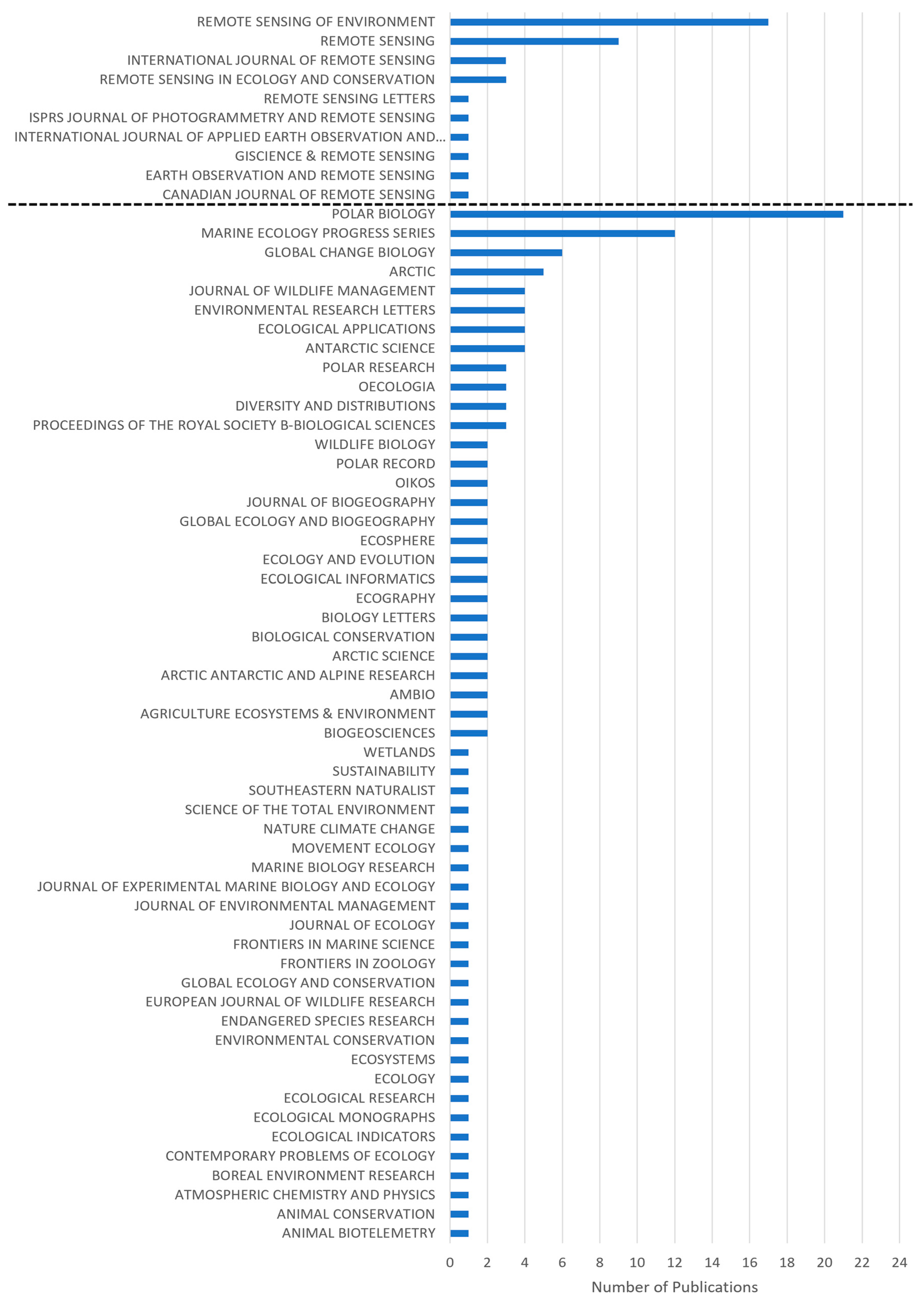
References
- Nogués-Bravo, D.; Araújo, M.B.; Errea, M.P.; Martínez-Rica, J.P. Exposure of Global Mountain Systems to Climate Warming during the 21st Century. Glob. Environ. Change 2007, 17, 420–428. [Google Scholar] [CrossRef]
- Calvin, K.; Dasgupta, D.; Krinner, G.; Mukherji, A.; Thorne, P.W.; Trisos, C.; Romero, J.; Aldunce, P.; Barrett, K.; Blanco, G.; et al. Contribution of Working Groups I, II and III to the Sixth Assessment Report of the Intergovernmental Panel on Climate Change. In Climate Change 2023: Synthesis Report; Lee, H., Romero, J., Eds.; IPCC: Geneva, Switzerland, 2023. [Google Scholar]
- Kim, Y.-H.; Min, S.-K.; Gillett, N.P.; Notz, D.; Malinina, E. Observationally-Constrained Projections of an Ice-Free Arctic Even under a Low Emission Scenario. Nat. Commun. 2023, 14, 3139. [Google Scholar] [CrossRef] [PubMed]
- Hoffmann, A.A.; Sgrò, C.M. Climate Change and Evolutionary Adaptation. Nature 2011, 470, 479–485. [Google Scholar] [CrossRef]
- Pacifici, M.; Visconti, P.; Butchart, S.H.M.; Watson, J.E.M.; Cassola, F.M.; Rondinini, C. Species’ Traits Influenced Their Response to Recent Climate Change. Nat. Clim. Change 2017, 7, 205–208. [Google Scholar] [CrossRef]
- Radchuk, V.; Reed, T.; Teplitsky, C.; van de Pol, M.; Charmantier, A.; Hassall, C.; Adamík, P.; Adriaensen, F.; Ahola, M.P.; Arcese, P.; et al. Adaptive Responses of Animals to Climate Change Are Most Likely Insufficient. Nat. Commun. 2019, 10, 3109. [Google Scholar] [CrossRef] [PubMed]
- Thomas, C.D.; Cameron, A.; Green, R.E.; Bakkenes, M.; Beaumont, L.J.; Collingham, Y.C.; Erasmus, B.F.N.; de Siqueira, M.F.; Grainger, A.; Hannah, L.; et al. Extinction Risk from Climate Change. Nature 2004, 427, 145–148. [Google Scholar] [CrossRef]
- Rosenzweig, C.; Karoly, D.; Vicarelli, M.; Neofotis, P.; Wu, Q.; Casassa, G.; Menzel, A.; Root, T.L.; Estrella, N.; Seguin, B.; et al. Attributing Physical and Biological Impacts to Anthropogenic Climate Change. Nature 2008, 453, 353–357. [Google Scholar] [CrossRef]
- Burek, K.A.; Gulland, F.M.D.; O’Hara, T.M. Effects of Climate Change on Arctic Marine Mammal Health. Ecol. Appl. 2008, 18, S126–S134. [Google Scholar] [CrossRef]
- Campbell, T.K.F.; Lantz, T.C.; Fraser, R.H. Impacts of Climate Change and Intensive Lesser snow goose (Chen caerulescens caerulescens) Activity on Surface Water in High Arctic Pond Complexes. Remote Sens. 2018, 10, 1892. [Google Scholar] [CrossRef]
- Rocchini, D.; Boyd, D.S.; Féret, J.-B.; Foody, G.M.; He, K.S.; Lausch, A.; Nagendra, H.; Wegmann, M.; Pettorelli, N. Satellite Remote Sensing to Monitor Species Diversity: Potential and Pitfalls. Remote Sens. Ecol. Conserv. 2016, 2, 25–36. [Google Scholar] [CrossRef]
- Pettorelli, N.; Schulte to Bühne, H.; Tulloch, A.; Dubois, G.; Macinnis-Ng, C.; Queirós, A.M.; Keith, D.A.; Wegmann, M.; Schrodt, F.; Stellmes, M.; et al. Satellite Remote Sensing of Ecosystem Functions: Opportunities, Challenges and Way Forward. Remote Sens. Ecol. Conserv. 2018, 4, 71–93. [Google Scholar] [CrossRef]
- Remelgado, R.; Leutner, B.; Safi, K.; Sonnenschein, R.; Kuebert, C.; Wegmann, M. Linking Animal Movement and Remote Sensing—Mapping Resource Suitability from a Remote Sensing Perspective. Remote Sens. Ecol. Conserv. 2018, 4, 211–224. [Google Scholar] [CrossRef]
- Evans, P.G.H.; Pierce, G.J.; Panigada, S. Climate Change and Marine Mammals. J. Mar. Biol. Assoc. UK 2010, 90, 1483–1487. [Google Scholar] [CrossRef]
- MacCracken, J.G. Pacific walrus and Climate Change: Observations and Predictions. Ecol. Evol. 2012, 2, 2072–2090. [Google Scholar] [CrossRef]
- Obbard, M.E.; Cattet, M.R.L.; Howe, E.J.; Middel, K.R.; Newton, E.J.; Kolenosky, G.B.; Abraham, K.F.; Greenwood, C.J. Trends in Body Condition in Polar Bears (Ursus maritimus) from the Southern Hudson Bay Subpopulation in Relation to Changes in Sea Ice. Arct. Sci. 2016, 2, 15–32. [Google Scholar] [CrossRef]
- Huntington, H.P.; Quakenbush, L.T.; Nelson, M. Evaluating the Effects of Climate Change on Indigenous Marine Mammal Hunting in Northern and Western Alaska Using Traditional Knowledge. Front. Mar. Sci. 2017, 4, 319. [Google Scholar] [CrossRef]
- Gulland, F.M.D.; Baker, J.D.; Howe, M.; LaBrecque, E.; Leach, L.; Moore, S.E.; Reeves, R.R.; Thomas, P.O. A Review of Climate Change Effects on Marine Mammals in United States Waters: Past Predictions, Observed Impacts, Current Research and Conservation Imperatives. Clim. Change Ecol. 2022, 3, 100054. [Google Scholar] [CrossRef]
- Barber, D.G.; Lukovich, J.V.; Keogak, J.; Baryluk, S.; Fortier, L.; Henry, G.H.R. The Changing Climate of the Arctic. Arctic 2008, 61, 7–26. [Google Scholar] [CrossRef]
- Hulme, P. Adapting to Climate Change: Is There Scope for Ecological Management in the Face of a Global Threat? J. Appl. Ecol. 2005, 42, 784–794. [Google Scholar] [CrossRef]
- Tveraa, T.; Fauchald, P.; Yoccoz, N.G.; Ims, R.A.; Aanes, R.; Hogda, K.A. What Regulate and Limit Reindeer Populations in Norway? Oikos 2007, 116, 706–715. [Google Scholar] [CrossRef]
- Mawdsley, J.; O’malley, R.; Ojima, D. A Review of Climate—Change Adaptation Strategies for Wildlife Management and Biodiversity Conservation. Conserv. Biol. 2009, 23, 1080–1089. [Google Scholar] [CrossRef] [PubMed]
- Sharma, S.; Couturier, S.; Cote, S.D. Impacts of Climate Change on the Seasonal Distribution of Migratory Caribou. Glob. Change Biol. 2009, 15, 2549–2562. [Google Scholar] [CrossRef]
- Bartsch, A.; Kumpula, T.; Forbes, B.C.; Stammler, F. Detection of Snow Surface Thawing and Refreezing in the Eurasian Arctic with QuikSCAT: Implications for Reindeer Herding. Ecol. Appl. 2010, 20, 2346–2358. [Google Scholar] [CrossRef]
- Franks, S.; Hoffmann, A. Genetics of Climate Change Adaptation. Annu. Rev. Genet. 2012, 46, 185–208. [Google Scholar] [CrossRef]
- Stein, B.; Staudt, A.; Cross, M.S.; Dubois, N.S.; Enquist, C.; Griffis, R.; Hansen, L.; Hellmann, J.; Lawler, J.; Nelson, E.; et al. Preparing for and Managing Change: Climate Adaptation for Biodiversity and Ecosystems. Front. Ecol. Environ. 2013, 11, 502–510. [Google Scholar] [CrossRef]
- Jenkins, D.A.; Lecomte, N.; Schaefer, J.A.; Olsen, S.M.; Swingedouw, D.; Cote, S.D.; Pellissier, L.; Yannic, G. Loss of Connectivity among Island-Dwelling Peary Caribou Following Sea Ice Decline. Biol. Lett. 2016, 12, 20160235. [Google Scholar] [CrossRef]
- Leblond, M.; St-Laurent, M.-H.; Cote, S.D. Caribou, Water, and Ice—Fine-Scale Movements of a Migratory Arctic Ungulate in the Context of Climate Change. Mov. Ecol. 2016, 4, 14. [Google Scholar] [CrossRef]
- John, C.; Miller, D.; Post, E. Regional Variation in Green-up Timing along a Caribou Migratory Corridor: Spatial Associations with Snowmelt and Temperature. Arct. Antarct. Alp. Res. 2020, 52, 416–423. [Google Scholar] [CrossRef]
- Goebel, M.E.; Perryman, W.L.; Hinke, J.T.; Krause, D.J.; Hann, N.A.; Gardner, S.; LeRoi, D.J. A Small Unmanned Aerial System for Estimating Abundance and Size of Antarctic Predators. Polar Biol. 2015, 38, 619–630. [Google Scholar] [CrossRef]
- Kavanaugh, M.T.; Abdala, F.N.; Ducklow, H.; Glover, D.; Fraser, W.; Martinson, D.; Stammerjohn, S.; Schofield, O.; Doney, S.C. Effect of Continental Shelf Canyons on Phytoplankton Biomass and Community Composition along the Western Antarctic Peninsula. Mar. Ecol. Prog. Ser. 2015, 524, 11–26. [Google Scholar] [CrossRef]
- Herr, H.; Viquerat, S.; Siegel, V.; Kock, K.-H.; Dorschel, B.; Huneke, W.G.C.; Bracher, A.; Schroeder, M.; Gutt, J. Horizontal Niche Partitioning of Humpback and Fin Whales around the West Antarctic Peninsula: Evidence from a Concurrent Whale and Krill Survey. Polar Biol. 2016, 39, 799–818. [Google Scholar] [CrossRef]
- Goncalves, B.C.; Spitzbart, B.; Lynch, H.J. SealNet: A Fully-Automated Pack-Ice Seal Detection Pipeline for Sub-Meter Satellite Imagery. Remote Sens. Environ. 2020, 239, 111617. [Google Scholar] [CrossRef]
- Wege, M.; Salas, L.; LaRue, M. Ice Matters: Life-History Strategies of Two Antarctic Seals Dictate Climate Change Eventualities in the Weddell Sea. Glob. Change Biol. 2021, 27, 6252–6262. [Google Scholar] [CrossRef] [PubMed]
- Abraham, K.; Jefferies, R.; Alisauskas, R. The Dynamics of Landscape Change and Snow Geese in Mid-Continent North America. Glob. Change Biol. 2005, 11, 841–855. [Google Scholar] [CrossRef]
- Tombre, I.; Madsen, J.; Tommervik, H.; Haugen, K.; Eythorsson, E. Influence of Organised Scaring on Distribution and Habitat Choice of Geese on Pastures in Northern Norway. Agric. Ecosyst. Environ. 2005, 111, 311–320. [Google Scholar] [CrossRef]
- Tombre, I.; Tommervik, H.; Madsen, J. Land Use Changes and Goose Habitats, Assessed by Remote Sensing Techniques, and Corresponding Goose Distribution, in Vesteralen, Northern Norway. Agric. Ecosyst. Environ. 2005, 109, 284–296. [Google Scholar] [CrossRef]
- Barber, D.; Iacozza, J. Historical Analysis of Sea Ice Conditions in M’Clintock Channel and the Gulf of Boothia, Nunavut: Implications for Ringed Seal and Polar Bear Habitat. Arctic 2004, 57, 1–14. [Google Scholar] [CrossRef][Green Version]
- Stirling, I.; Parkinson, C.L. Possible Effects of Climate Warming on Selected Populations of Polar Bears (Ursus Maritimus) in the Canadian Arctic. Arctic 2006, 59, 261–275. [Google Scholar] [CrossRef]
- Sahanatien, V.; Derocher, A.E. Monitoring Sea Ice Habitat Fragmentation for Polar Bear Conservation. Anim. Conserv. 2012, 15, 397–406. [Google Scholar] [CrossRef]
- Young, K.L.; Brown, L.; Labine, C. Snow Cover Variability at Polar Bear Pass, Nunavut. Arct. Sci. 2018, 4, 669–690. [Google Scholar] [CrossRef]
- Awange, J.; Kiema, J. Fundamentals of Remote Sensing. In Environmental Geoinformatics; Springer: Berlin/Heidelberg, Germany, 2004. [Google Scholar] [CrossRef]
- Kennedy, R.; Townsend, P.; Gross, J.; Cohen, W.; Bolstad, P.; Wang, Y.; Adams, P. Remote Sensing Change Detection Tools for Natural Resource Managers: Understanding Concepts and Tradeoffs in the Design of Landscape Monitoring Projects. Remote Sens. Environ. 2009, 113, 1382–1396. [Google Scholar] [CrossRef]
- Toth, C.; Jóźków, G. Remote Sensing Platforms and Sensors: A Survey. ISPRS J. Photogramm. Remote Sens. 2016, 115, 22–36. [Google Scholar] [CrossRef]
- Wang, Q.; Shi, W.; Li, Z.; Atkinson, P. Fusion of Sentinel-2 Images. Remote Sens. Environ. 2016, 187, 241–252. [Google Scholar] [CrossRef]
- Pettorelli, N.; Safi, K.; Turner, W. Satellite Remote Sensing, Biodiversity Research and Conservation of the Future. Philos. Trans. R. Soc. B Biol. Sci. 2014, 369, 20130190. [Google Scholar] [CrossRef]
- Wehner, H.; Fritz, J.; Voelkl, B. Soaring and Intermittent Flap-Gliding during Migratory Flights of Northern Bald Ibis. J. Ornithol. 2022, 163, 671–681. [Google Scholar] [CrossRef]
- Laidre, K.L.; Heide-Jorgensen, M.P.; Logsdon, M.L.; Delwiche, L.; Nielsen, T.G. A Whale of an Opportunity: Examining the Vertical Structure of Chlorophyll-a in High Arctic Waters Using Instrumented Marine Predators. Mar. Biol. Res. 2010, 6, 519–529. [Google Scholar] [CrossRef]
- Linsky, J.M.J.; Wilson, N.; Cade, D.E.; Goldbogen, J.A.; Johnston, D.W.; Friedlaender, A.S. The Scale of the Whale: Using Video-Tag Data to Evaluate Sea-Surface Ice Concentration from the Perspective of Individual Antarctic Minke Whales. Anim. Bio. 2020, 8, 31. [Google Scholar] [CrossRef]
- Remelgado, R.; Safi, K.; Wegmann, M. From Ecology to Remote Sensing: Using Animals to Map Land Cover. Remote Sens. Ecol. Conserv. 2020, 6, 93–104. [Google Scholar] [CrossRef]
- Larue, M.A.; Knight, J. Applications of Very High-Resolution Imagery in the Study and Conservation of Large Predators in the Southern Ocean. Conserv. Biol. 2014, 28, 1731–1735. [Google Scholar] [CrossRef]
- Witharana, C.; Lynch, H.J. An Object-Based Image Analysis Approach for Detecting Penguin Guano in Very High Spatial Resolution Satellite Images. Remote Sens. 2016, 8, 375. [Google Scholar] [CrossRef]
- Witharana, C.; LaRue, M.A.; Lynch, H.J. Benchmarking of Data Fusion Algorithms in Support of Earth Observation Based Antarctic Wildlife Monitoring. ISPRS J. Photogramm. Remote Sens. 2016, 113, 124–143. [Google Scholar] [CrossRef]
- Rees, W.G.; Brown, J.A.; Fretwell, P.T.; Trathan, P.N. What Colour Is Penguin Guano? Antarct. Sci. 2017, 29, 417–425. [Google Scholar] [CrossRef]
- Larue, M.; Iles, D.; Labrousse, S.; Salas, L.; Ballard, G.; Ainley, D.; Saenz, B. A Possible Adelie Penguin Sub-Colony on Fast Ice by Cape Crozier, Antarctica. Antarct. Sci. 2019, 31, 189–194. [Google Scholar] [CrossRef]
- LaRue, M.A.; Ainley, D.G.; Pennycook, J.; Stamatiou, K.; Salas, L.; Nur, N.; Stammerjohn, S.; Barrington, L. Engaging ‘the Crowd’ in Remote Sensing to Learn about Habitat Affinity of the Weddell Seal in Antarctica. Remote Sens. Ecol. Conserv. 2020, 6, 70–78. [Google Scholar] [CrossRef]
- Haddaway, N.R.; Page, M.J.; Pritchard, C.C.; McGuinness, L.A. PRISMA2020: An R Package and Shiny App for Producing PRISMA 2020-Compliant Flow Diagrams, with Interactivity for Optimised Digital Transparency and Open Synthesis. Campbell Syst. Rev. 2022, 18, e1230. [Google Scholar] [CrossRef]
- Page, M.J.; McKenzie, J.E.; Bossuyt, P.M.; Boutron, I.; Hoffmann, T.C.; Mulrow, C.D.; Shamseer, L.; Tetzlaff, J.M.; Akl, E.A.; Brennan, S.E.; et al. The PRISMA 2020 Statement: An Updated Guideline for Reporting Systematic Reviews. BMJ 2021, 372, n71. [Google Scholar] [CrossRef]
- Spanier, R.; Kuenzer, C. Marine Infrastructure Detection with Satellite Data—A Review. Remote Sens. 2024, 16, 1675. [Google Scholar] [CrossRef]
- Baumhoer, C.A.; Dietz, A.J.; Dech, S.; Kuenzer, C. Remote Sensing of Antarctic Glacier and Ice-Shelf Front Dynamics—A Review. Remote Sens. 2018, 10, 1445. [Google Scholar] [CrossRef]
- Hu, Z.; Kuenzer, C.; Dietz, A.J.; Dech, S. The Potential of Earth Observation for the Analysis of Cold Region Land Surface Dynamics in Europe—A Review. Remote Sens. 2017, 9, 1067. [Google Scholar] [CrossRef]
- Koehler, J.; Kuenzer, C. Forecasting Spatio-Temporal Dynamics on the Land Surface Using Earth Observation Data—A Review. Remote Sens. 2020, 12, 3513. [Google Scholar] [CrossRef]
- Schilling, S.; Dietz, A.; Kuenzer, C. Snow Water Equivalent Monitoring—A Review of Large-Scale Remote Sensing Applications. Remote Sens. 2024, 16, 1085. [Google Scholar] [CrossRef]
- Tsai, Y.-L.S.; Dietz, A.; Oppelt, N.; Kuenzer, C. Remote Sensing of Snow Cover Using Spaceborne SAR: A Review. Remote Sens. 2019, 11, 1456. [Google Scholar] [CrossRef]
- Wenzl, M.; Baumhoer, C.A.; Dietz, A.J.; Kuenzer, C. Vegetation Changes in the Arctic: A Review of Earth Observation Applications. Remote Sens. 2024, 16, 4509. [Google Scholar] [CrossRef]
- Leblanc, G.; Francis, C.M.; Soffer, R.; Kalacska, M.; de Gea, J. Spectral Reflectance of Polar Bear and Other Large Arctic Mammal Pelts; Potential Applications to Remote Sensing Surveys. Remote Sens. 2016, 8, 273. [Google Scholar] [CrossRef]
- Richter, S.; Gerum, R.C.; Schneider, W.; Fabry, B.; Le Bohec, C.; Zitterbart, D.P. A Remote-Controlled Observatory for Behavioural and Ecological Research: A Case Study on Emperor Penguins. Methods Ecol. Evol. 2018, 9, 1168–1178. [Google Scholar] [CrossRef]
- Hani, U.E.; Haq, S.M.; Shabbir, R.; Waheed, M.; Jabeen, A.; Hussain, M.; Najar, Z.H.; Alhimaidi, A.R.; Amran, R.A.; Bussmann, R.W. Geospatial Assessment of Climate and Human Pressure on Snow Leopard Habitat in the Trans-Himalayan Region of Pakistan. Glob. Ecol. Conserv. 2024, 53, e03024. [Google Scholar] [CrossRef]
- Barber-Meyer, S.M.; Kooyman, G.L.; Ponganis, P.J. Estimating the Relative Abundance of Emperor Penguins at Inaccessible Colonies Using Satellite Imagery. Polar Biol. 2007, 30, 1565–1570. [Google Scholar] [CrossRef]
- LaRue, M.; Iles, D.; Labrousse, S.; Fretwell, P.; Ortega, D.; Devane, E.; Horstmann, I.; Viollat, L.; Foster-Dyer, R.; Le Bohec, C.; et al. Advances in Remote Sensing of Emperor Penguins: First Multi-Year Time Series Documenting Trends in the Global Population. Proc. R. Soc. B Biol. Sci. 2024, 291, 20232067. [Google Scholar] [CrossRef]
- Madsen, J.; Tamstorf, M.; Klaassen, M.; Eide, N.; Glahder, C.; Riget, F.; Nyegaard, H.; Cottaar, F. Effects of Snow Cover on the Timing and Success of Reproduction in High-Arctic Pink-Footed Geese Anser Brachyrhynchus. Polar Biol. 2007, 30, 1363–1372. [Google Scholar] [CrossRef]
- Slattery, S.M.; Alisauskas, R.T. Distribution and Habitat Use of Ross’s and Lesser Snow Geese during Late Brood Rearing. J. Wildl. Manag. 2007, 71, 2230–2237. [Google Scholar] [CrossRef]
- Hansen, M.; Franklin, S.; Woudsma, C.; Peterson, M. Caribou Habitat Mapping and Fragmentation Analysis Using Landsat MSS, TM, and GIS Data in the North Columbia Mountains, British Columbia, Canada. Remote Sens. Environ. 2001, 77, 50–65. [Google Scholar] [CrossRef]
- Bechtel, R.; Sanchez-Azofeifa, A.; Rivard, B. Associations between Woodland Caribou Telemetry Data and Landsat TM Spectral Reflectance. Int. J. Remote Sens. 2004, 25, 4813–4827. [Google Scholar] [CrossRef]
- Verma, M.; Buehne, H.S.T.; Lopes, M.; Ehrich, D.; Sokovnina, S.; Hofhuis, S.P.; Pettorelli, N. Can Reindeer Husbandry Management Slow down the Shrubification of the Arctic? J. Environ. Manage. 2020, 267, 110636. [Google Scholar] [CrossRef]
- Romtveit, L.; Strand, O.; Mossing, A.; Kastdalen, L.; Hjeltnes, A.W.; Bjerketvedt, D.K.; Odland, A.; Heggenes, J. Optimal Foraging by a Large Ungulate in an Extreme Environment: Wild Mountain Reindeer Select Snow-Free Feeding Habitats in Winter. Ecol. Evol. 2021, 11, 10409–10420. [Google Scholar] [CrossRef] [PubMed]
- Dettki, H.; Lofstrand, R.; Edenius, L. Modeling Habitat Suitability for Moose in Coastal Northern Sweden: Empirical vs Process-Oriented Approaches. AMBIO 2003, 32, 549–556. [Google Scholar] [CrossRef]
- Nikula, A.; Heikkinen, S.; Helle, E. Habitat Selection of Adult Moose Alces Alces at Two Spatial Scales in Central Finland. Wildl. Biol. 2004, 10, 121–135. [Google Scholar] [CrossRef]
- Michaud, J.-S.; Coops, N.C.; Andrew, M.E.; Wulder, M.A.; Brown, G.S.; Rickbeil, G.J.M. Estimating Moose (Alces alces) Occurrence and Abundance from Remotely Derived Environmental Indicators. Remote Sens. Environ. 2014, 152, 190–201. [Google Scholar] [CrossRef]
- Rae, L.F.; Whitaker, D.M.; Warkentin, I.G. Multiscale Impacts of Forest Degradation through Browsing by Hyperabundant Moose (Alces alces) on Songbird Assemblages. Divers. Distrib. 2014, 20, 382–395. [Google Scholar] [CrossRef]
- Gagne, C.; Mainguy, J.; Fortin, D. The Impact of Forest Harvesting on Caribou–Moose–Wolf Interactions Decreases along a Latitudinal Gradient. Biol. Conserv. 2016, 197, 215–222. [Google Scholar] [CrossRef]
- Verbyla, D.; Hegel, T.; Nolin, A.W.; van de Kerk, M.; Kurkowski, T.A.; Prugh, L.R. Remote Sensing of 2000–2016 Alpine Spring Snowline Elevation in Dall Sheep Mountain Ranges of Alaska and Western Canada. Remote Sens. 2017, 9, 1157. [Google Scholar] [CrossRef]
- van de Kerk, M.; Verbyla, D.; Nolin, A.W.; Sivy, K.J.; Prugh, L.R. Range-Wide Variation in the Effect of Spring Snow Phenology on Dall Sheep Population Dynamics. Environ. Res. Lett. 2018, 13, 075008. [Google Scholar] [CrossRef]
- Van de Kerk, M.; Arthur, S.; Bertram, M.; Borg, B.; Herriges, J.; Lawler, J.; Mangipane, B.; Koizumi, C.L.; Wendling, B.; Prugh, L. Environmental Influences on Dall’s Sheep Survival. J. Wildl. Manag. 2020, 84, 1127–1138. [Google Scholar] [CrossRef]
- Maher, A.I.; Treitz, P.M.; Ferguson, M.A.D. Can Landsat Data Detect Variations in Snow Cover within Habitats of Arctic Ungulates? Wildl. Biol. 2012, 18, 75–87. [Google Scholar] [CrossRef]
- Villamuelas, M.; Fernandez, N.; Albanell, E.; Galvez-Ceron, A.; Bartolome, J.; Mentaberre, G.; Lopez-Olvera, J.R.; Fernandez-Aguilar, X.; Colom-Cadena, A.; Maria Lopez-Martin, J.; et al. The Enhanced Vegetation Index (EVI) as a Proxy for Diet Quality and Composition in a Mountain Ungulate. Ecol. Indic. 2016, 61, 658–666. [Google Scholar] [CrossRef]
- Edenius, L.; Vencatasawmy, C.; Sandstrom, P.; Dahlberg, U. Combining Satellite Imagery and Ancillary Data to Map Snowbed Vegetation Important to Reindeer Rangifer Tarandus. Arct. Antarct. Alp. Res. 2003, 35, 150–157. [Google Scholar] [CrossRef]
- Falldorf, T.; Strand, O.; Panzacchi, M.; Tommervik, H. Estimating Lichen Volume and Reindeer Winter Pasture Quality from Landsat Imagery. Remote Sens. Environ. 2014, 140, 573–579. [Google Scholar] [CrossRef]
- Mahoney, P.J.; Liston, G.E.; LaPoint, S.; Gurarie, E.; Mangipane, B.; Wells, A.G.; Brinkman, T.J.; Eitel, J.U.H.; Hebblewhite, M.; Nolin, A.W.; et al. Navigating Snowscapes: Scale-Dependent Responses of Mountain Sheep to Snowpack Properties. Ecol. Appl. 2018, 28, 1715–1729. [Google Scholar] [CrossRef]
- MacSween, J.; Leroux, S.J.; Oakes, K.D. Cross-Ecosystem Effects of a Large Terrestrial Herbivore on Stream Ecosystem Functioning. Oikos 2019, 128, 135–145. [Google Scholar] [CrossRef]
- McLeod, L.J.T.; DeLancey, E.R.; Bayne, E.M. Spatially Explicit Abundance Modeling of a Highly Specialized Wetland Bird Using Sentinel-1 and Sentinel-2 Modélisation Spatialement Explicite de l’abondance d’un Oiseau Très Spécifique Aux Zones Humides à l’aide de Sentinel-1 et de Sentinel-2. Can. J. Remote Sens. 2022, 48, 37–54. [Google Scholar] [CrossRef]
- Cotte, C.; Park, Y.-H.; Guinet, C.; Bost, C.-A. Movements of Foraging King Penguins through Marine Mesoscale Eddies. Proc. R. Soc. B-Biol. Sci. 2007, 274, 2385–2391. [Google Scholar] [CrossRef]
- Massom, R.A.; Hill, K.; Barbraud, C.; Adams, N.; Ancel, A.; Emmerson, L.; Pook, M.J. Fast Ice Distribution in Adélie Land, East Antarctica: Interannual Variability and Implications for Emperor Penguins Aptenodytes Forsteri. Mar. Ecol. Prog. Ser. 2009, 374, 243–257. [Google Scholar] [CrossRef]
- Savidge, E.; Snow, T.; Siegfried, M.R.; Zheng, Y.; Bôas, A.B.V.; Bortolotto, G.A.; Boehme, L.; Alley, K.E. Wintertime Polynya Structure and Variability From Thermal Remote Sensing and Seal-Borne Observations at Pine Island Glacier, West Antarctica. IEEE Trans. Geosci. Remote Sens. 2023, 61, 4300813. [Google Scholar] [CrossRef]
- Kharuk, V.; Ranson, K.; Kozuhovskaya, A.; Kondakov, Y.; Pestunov, I. NOAA/AVHRR Satellite Detection of Siberian Silkmoth Outbreaks in Eastern Siberia. Int. J. Remote Sens. 2004, 25, 5543–5555. [Google Scholar] [CrossRef]
- Rickbeil, G.J.M.; Hermosilla, T.; Coops, N.C.; White, J.C.; Wulder, M.A. Barren-Ground Caribou (Rangifer Tarandus Groenlandicus) Behaviour after Recent Fire Events; Integrating Caribou Telemetry Data with Landsat Fire Detection Techniques. Glob. Change Biol. 2017, 23, 1036–1047. [Google Scholar] [CrossRef] [PubMed]
- Jepsen, J.U.; Hagen, S.B.; Hogda, K.A.; Ims, R.A.; Karlsen, S.R.; Tommervik, H.; Yoccoz, N.G. Monitoring the Spatio-Temporal Dynamics of Geometrid Moth Outbreaks in Birch Forest Using MODIS-NDVI Data. Remote Sens. Environ. 2009, 113, 1939–1947. [Google Scholar] [CrossRef]
- Bleyhl, B.; Baumann, M.; Griffiths, P.; Heidelberg, A.; Manvelyan, K.; Radeloff, V.C.; Zazanashvili, N.; Kuemmerle, T. Assessing Landscape Connectivity for Large Mammals in the Caucasus Using Landsat 8 Seasonal Image Composites. Remote Sens. Environ. 2017, 193, 193–203. [Google Scholar] [CrossRef]
- Sittler, K.L.; Parker, K.L.; Gillingham, M.P. Vegetation and Prescribed Fire: Implications for Stone’s Sheep and Elk. J. Wildl. Manag. 2019, 83, 393–409. [Google Scholar] [CrossRef]
- Roman, A.; Navarro, G.; Caballero, I.; Tovar-Sanchez, A. High-Spatial Resolution UAV Multispectral Data Complementing Satellite Imagery to Characterize a Chinstrap Penguin Colony Ecosystem on Deception Island (Antarctica). GIScience Remote Sens. 2022, 59, 1159–1176. [Google Scholar] [CrossRef]
- Ferguson, S.; Taylor, M.; Messier, F. Influence of Sea Ice Dynamics on Habitat Selection by Polar Bears. Ecology 2000, 81, 761–772. [Google Scholar] [CrossRef]
- Doniol-Valcroze, T.; Berteaux, D.; Larouche, P.; Sears, R. Influence of Thermal Fronts on Habitat Selection by Four Rorqual Whale Species in the Gulf of St. Lawrence. Mar. Ecol. Prog. Ser. 2007, 335, 207–216. [Google Scholar] [CrossRef]
- Gautier, C.; Langlois, A.; Sasseville, V.; Neave, E.; Johnson, C.A. Remote Sensing, Snow Modelling, Survey Data and Indigenous Knowledge Show How Snow and Sea-Ice Conditions Affect Peary Caribou (Rangifer Tarandus Pearyi) Distribution and Inter-Island and Island–Mainland Movements. Polar Res. 2022, 41, 7964. [Google Scholar] [CrossRef]
- Jensen, G.H.; Madsen, J.; Johnson, F.A.; Tamstorf, M.P. Snow Conditions as an Estimator of the Breeding Output in High-Arctic Pink-Footed Geese Anser Brachyrhynchus. Polar Biol. 2014, 37, 1–14. [Google Scholar] [CrossRef]
- Jefferies, R.; Jano, A.; Abraham, K. A Biotic Agent Promotes Large-Scale Catastrophic Change in the Coastal Marshes of Hudson Bay. J. Ecol. 2006, 94, 234–242. [Google Scholar] [CrossRef]
- Rickbeil, G.J.M.; Hermosilla, T.; Coops, N.C.; White, J.C.; Wulder, M.A.; Lantz, T.C. Changing Northern Vegetation Conditions Are Influencing Barren Ground Caribou (Rangifer Tarandus Groenlandicus) Post-Calving Movement Rates. J. Biogeogr. 2018, 45, 702–712. [Google Scholar] [CrossRef]
- Kennedy, B.; Pouliot, D.; Manseau, M.; Fraser, R.; Duffe, J.; Pasher, J.; Chen, W.; Olthof, I. Assessment of Landsat-Based Terricolous Macrolichen Cover Retrieval and Change Analysis over Caribou Ranges in Northern Canada and Alaska. Remote Sens. Environ. 2020, 240, 111694. [Google Scholar] [CrossRef]
- Komers, P.E.; Stanojevic, Z. Rates of Disturbance Vary by Data Resolution: Implications for Conservation Schedules Using the Alberta Boreal Forest as a Case Study. Glob. Change Biol. 2013, 19, 2916–2928. [Google Scholar] [CrossRef]
- Nelson, P.R.; Roland, C.; Macander, M.J.; McCune, B. Detecting Continuous Lichen Abundance for Mapping Winter Caribou Forage at Landscape Spatial Scales. Remote Sens. Environ. 2013, 137, 43–54. [Google Scholar] [CrossRef]
- Newton, E.J.; Pond, B.A.; Brown, G.S.; Abraham, K.F.; Schaefer, J.A. Remote Sensing Reveals Long-Term Effects of Caribou on Tundra Vegetation. Polar Biol. 2014, 37, 715–725. [Google Scholar] [CrossRef]
- Keim, J.L.; DeWitt, P.D.; Fitzpatrick, J.J.; Jenni, N.S. Estimating Plant Abundance Using Inflated Beta Distributions: Applied Learnings from a Lichen-Caribou Ecosystem. Ecol. Evol. 2017, 7, 486–493. [Google Scholar] [CrossRef]
- Le, H.; Samaras, D.; Lynch, H.J. A Convolutional Neural Network Architecture Designed for the Automated Survey of Seabird Colonies. Remote Sens. Ecol. Conserv. 2022, 8, 251–262. [Google Scholar] [CrossRef]
- Bird, C.N.; Dawn, A.H.; Dale, J.; Johnston, D.W. A Semi-Automated Method for Estimating Adelie Penguin Colony Abundance from a Fusion of Multispectral and Thermal Imagery Collected with Unoccupied Aircraft Systems. Remote Sens. 2020, 12, 3692. [Google Scholar] [CrossRef]
- Wu, J.; Xu, W.; He, J.; Lan, M. YOLO for Penguin Detection and Counting Based on Remote Sensing Images. Remote Sens. 2023, 15, 2598. [Google Scholar] [CrossRef]
- Lynch, H.J.; White, R.; Black, A.D.; Naveen, R. Detection, Differentiation, and Abundance Estimation of Penguin Species by High-Resolution Satellite Imagery. Polar Biol. 2012, 35, 963–968. [Google Scholar] [CrossRef]
- Fischbach, A.S.; Douglas, D.C. Evaluation of Satellite Imagery for Monitoring Pacific Walruses at a Large Coastal Haulout. Remote Sens. 2021, 13, 4266. [Google Scholar] [CrossRef]
- Shen, X.-Y.; Ke, C.-Q.; Miao, X.; Zhang, X.; Zhang, J. An Automated Method for the Detection of Emperor Penguin Colonies from Landsat 8 Imagery. Remote Sens. Lett. 2017, 8, 596–605. [Google Scholar] [CrossRef]
- Santora, J.A.; LaRue, M.A.; Ainley, D.G. Geographic Structuring of Antarctic Penguin Populations. Glob. Ecol. Biogeogr. 2020, 29, 1716–1728. [Google Scholar] [CrossRef]
- Macander, M.J.; Palm, E.C.; Frost, G.V.; Herriges, J.D.; Nelson, P.R.; Roland, C.; Russell, K.L.M.; Suitor, M.J.; Bentzen, T.W.; Joly, K.; et al. Lichen Cover Mapping for Caribou Ranges in Interior Alaska and Yukon. Environ. Res. Lett. 2020, 15, 055001. [Google Scholar] [CrossRef]
- Schwaller, M.R.; Lynch, H.J.; Tarroux, A.; Prehn, B. A Continent-Wide Search for Antarctic Petrel Breeding Sites with Satellite Remote Sensing. Remote Sens. Environ. 2018, 210, 444–451. [Google Scholar] [CrossRef]
- Cohen, J.Y.; Pulliainen, J.; Menard, C.B.; Johansen, B.; Oksanen, L.; Luojus, K.; Ikonen, J. Effect of Reindeer Grazing on Snowmelt, Albedo and Energy Balance Based on Satellite Data Analyses. Remote Sens. Environ. 2013, 135, 107–117. [Google Scholar] [CrossRef]
- Laidre, K.L.; Heide-Jorgensen, M.P.; Nyeland, J.; Mosbech, A.; Boertmann, D. Latitudinal Gradients in Sea Ice and Primary Production Determine Arctic Seabird Colony Size in Greenland. Proc. R. Soc. B-Biol. Sci. 2008, 275, 2695–2702. [Google Scholar] [CrossRef]
- Muukkonen, P.; Angervuori, A.; Virtanen, T.; Kuparinen, A.; Merila, J. Loss and Fragmentation of Siberian Jay (Perisoreus infaustus) Habitats. Boreal Environ. Res. 2012, 17, 59–71. [Google Scholar]
- Prendin, A.L.; Carrer, M.; Karami, M.; Hollesen, J.; Pedersen, N.B.; Pividori, M.; Treier, U.A.; Westergaard-Nielsen, A.; Elberling, B.; Normand, S. Immediate and Carry-over Effects of Insect Outbreaks on Vegetation Growth in West Greenland Assessed from Cells to Satellite. J. Biogeogr. 2020, 47, 87–100. [Google Scholar] [CrossRef]
- Johnson, H.E.; Gustine, D.D.; Golden, T.S.; Adams, L.G.; Parrett, L.S.; Lenart, E.A.; Barboza, P.S. NDVI Exhibits Mixed Success in Predicting Spatiotemporal Variation in Caribou Summer Forage Quality and Quantity. Ecosphere 2018, 9, e02461. [Google Scholar] [CrossRef]
- Rickbeil, G.J.M.; Coops, N.C.; Adamczewski, J. The Grazing Impacts of Four Barren Ground Caribou Herds (Rangifer Tarandus Groenlandicus) on Their Summer Ranges: An Application of Archived Remotely Sensed Vegetation Productivity Data. Remote Sens. Environ. 2015, 164, 314–323. [Google Scholar] [CrossRef]
- Himmelberger, A.; Frey, K.E.; Sangermano, F. Applying Landscape Fragmentation Analysis to Icescape Environments: Potential Impacts for the Pacific Walrus (Odobenus rosmarus divergens). Polar Res. 2022, 41, 5169. [Google Scholar] [CrossRef]
- Chen, X.; Chen, J.; Cheng, X.; Zhu, L.; Li, B.; Li, X. Retreating Shorelines as an Emerging Threat to Adelie Penguins on Inexpressible Island. Remote Sens. 2021, 13, 4718. [Google Scholar] [CrossRef]
- Lameris, T.K.; de Jong, M.E.; Boom, M.P.; van der Jeugd, H.P.; Litvin, K.E.; Loonen, M.J.J.E.; Nolet, B.A.; Prop, J. Climate Warming May Affect the Optimal Timing of Reproduction for Migratory Geese Differently in the Low and High Arctic. Oecologia 2019, 191, 1003–1014. [Google Scholar] [CrossRef]
- Dickens, J.; Hollyman, P.R.; Hart, T.; Clucas, G.V.; Murphy, E.J.; Poncet, S.; Trathan, P.N.; Collins, M.A. Developing UAV Monitoring of South Georgia and the South Sandwich Islands’ Iconic Land-Based Marine Predators. Front. Mar. Sci. 2021, 8, 654215. [Google Scholar] [CrossRef]
- Stirling, I.; Lunn, N.; Iacozza, J.; Elliott, C.; Obbard, M. Polar Bear Distribution and Abundance on the Southwestern Hudson Bay Coast during Open Water Season, in Relation to Population Trends and Annual Ice Patterns. Arctic 2004, 57, 15–26. [Google Scholar] [CrossRef]
- Jay, C.V.; Udevitz, M.S.; Kwok, R.; Fischbach, A.S.; Douglas, D.C. Divergent Movements of Walrus and Sea Ice in the Northern Bering Sea. Mar. Ecol. Prog. Ser. 2010, 407, 293–302. [Google Scholar] [CrossRef]
- Colpaert, A.; Kumpula, J. Detecting Changes in the State of Reindeer Pastures in Northernmost Finland, 1995–2005. Polar Rec. 2012, 48, 74–82. [Google Scholar] [CrossRef]
- Babst, F.; Esper, J.; Parlow, E. Landsat TM/ETM plus and Tree-Ring Based Assessment of Spatiotemporal Patterns of the Autumnal Moth (Epirrita Autumnata) in Northernmost Fennoscandia. Remote Sens. Environ. 2010, 114, 637–646. [Google Scholar] [CrossRef]
- Joutsensaari, J.; Yli-Pirila, P.; Korhonen, H.; Arola, A.; Blande, J.D.; Heijari, J.; Kivimaenpaa, M.; Mikkonen, S.; Hao, L.; Miettinen, P.; et al. Biotic Stress Accelerates Formation of Climate-Relevant Aerosols in Boreal Forests. Atmos. Chem. Phys. 2015, 15, 12139–12157. [Google Scholar] [CrossRef]
- Allard, M.; Fournier, R.A.; Grenier, M.; Lefebvre, J.; Giroux, J.-F. Forty Years of Change in the Bulrush Marshes of the St. Lawrence Estuary and The Impact of the Greater Snow Goose. Wetlands 2012, 32, 1175–1188. [Google Scholar] [CrossRef]
- Olofsson, J.; Tommervik, H.; Callaghan, T.V. Vole and Lemming Activity Observed from Space. Nat. Clim. Change 2012, 2, 880–883. [Google Scholar] [CrossRef]
- Boelman, N.T.; Liston, G.E.; Gurarie, E.; Meddens, A.J.H.; Mahoney, P.J.; Kirchner, P.B.; Bohrer, G.; Brinkman, T.J.; Cosgrove, C.L.; Eitel, J.U.H.; et al. Integrating Snow Science and Wildlife Ecology in Arctic-Boreal North America. Environ. Res. Lett. 2019, 14, 010401. [Google Scholar] [CrossRef]
- Fretwell, P.T.; Trathan, P.N. Emperors on Thin Ice: Three Years of Breeding Failure at Halley Bay. Antarct. Sci. 2019, 31, 133–138. [Google Scholar] [CrossRef]
- Iacozza, J.; Ferguson, S.H. Spatio-Temporal Variability of Snow over Sea Ice in Western Hudson Bay, with Reference to Ringed Seal Pup Survival. Polar Biol. 2014, 37, 817–832. [Google Scholar] [CrossRef]
- Henderson, E.M.; Derocher, A.E.; Lunn, N.J.; Montpetit, B.; Merrill, E.H.; Richardson, E.S. Polar Bear Ursus Maritimus Use of the Western Hudson Bay Flaw Lead. Mar. Ecol. Prog. Ser. 2021, 664, 227–242. [Google Scholar] [CrossRef]
- Ktitorov, P.; Ivanov, S.; Kornilova, E.; Kulikova, O.; Ris, H.; Sokolovskis, K.; Solovyeva, D. Shrub-Dwelling Species Are Joining the Arctic Passerine Bird Community in the Chaun Delta (Western Chukotka, Russia). Polar Biol. 2021, 44, 1847–1857. [Google Scholar] [CrossRef]
- Fretwell, P.T.; Phillips, R.A.; de L. Brooke, M.; Fleming, A.H.; McArthur, A. Using the Unique Spectral Signature of Guano to Identify Unknown Seabird Colonies. Remote Sens. Environ. 2015, 156, 448–456. [Google Scholar] [CrossRef]
- Gremillet, D.; Fort, J.; Amelineau, F.; Zakharova, E.; Le Bot, T.; Sala, E.; Gavrilo, M. Arctic Warming: Nonlinear Impacts of Sea-Ice and Glacier Melt on Seabird Foraging. Glob. Change Biol. 2015, 21, 1116–1123. [Google Scholar] [CrossRef] [PubMed]
- Labrousse, S.; Fraser, A.D.; Sumner, M.; Le Manach, F.; Sauser, C.; Horstmann, I.; Devane, E.; Delord, K.; Jenouvrier, S.; Barbraud, C. Landfast Ice: A Major Driver of Reproductive Success in a Polar Seabird. Biol. Lett. 2021, 17, 20210097. [Google Scholar] [CrossRef] [PubMed]
- Snapir, B.; Momblanch, A.; Jain, S.K.; Waine, T.W.; Holman, I.P. A Method for Monthly Mapping of Wet and Dry Snow Using Sentinel-1 and MODIS: Application to a Himalayan River Basin. Int. J. Appl. Earth Obs. Geoinf. 2019, 74, 222–230. [Google Scholar] [CrossRef]
- Imhoff, M.; Sisk, T.; Milne, A.; Morgan, G.; Orr, T. Remotely Sensed Indicators of Habitat Heterogeneity: Use of Synthetic Aperture Radar in Mapping Vegetation Structure and Bird Habitat. Remote Sens. Environ. 1997, 60, 217–227. [Google Scholar] [CrossRef]
- Fretwell, P.T.; Trathan, P.N. Penguins from Space: Faecal Stains Reveal the Location of Emperor Penguin Colonies. Glob. Ecol. Biogeogr. 2009, 18, 543–552. [Google Scholar] [CrossRef]
- LaRue, M.A.; Lynch, H.J.; Lyver, P.O.B.; Barton, K.; Ainley, D.G.; Pollard, A.; Fraser, W.R.; Ballard, G. A Method for Estimating Colony Sizes of Adélie Penguins Using Remote Sensing Imagery. Polar Biol. 2014, 37, 507–517. [Google Scholar] [CrossRef]
- Weimerskirch, H.; Le Bouard, F.; Ryan, P.G.; Bost, C.A. Massive Decline of the World’s Largest King Penguin Colony at Ile Aux Cochons, Crozet. Antarct. Sci. 2018, 30, 236–242. [Google Scholar] [CrossRef]
- LaRue, M.A.; Kooyman, G.; Lynch, H.J.; Fretwell, P. Emigration in Emperor Penguins: Implications for Interpretation of Long-Term Studies. Ecography 2015, 38, 114–120. [Google Scholar] [CrossRef]
- Meyer, N.; Bollache, L.; Galipaud, M.; Moreau, J.; Dechaume-Moncharmont, F.-X.; Afonso, E.; Angerbjorn, A.; Bety, J.; Brown, G.; Ehrich, D.; et al. Behavioural Responses of Breeding Arctic Sandpipers to Ground-Surface Temperature and Primary Productivity. Sci. Total Environ. 2021, 755, 142485. [Google Scholar] [CrossRef]
- Hogrefe, K.R.; Patil, V.P.; Ruthrauff, D.R.; Meixell, B.W.; Budde, M.E.; Hupp, J.W.; Ward, D.H. Normalized Difference Vegetation Index as an Estimator for Abundance and Quality of Avian Herbivore Forage in Arctic Alaska. Remote Sens. 2017, 9, 1234. [Google Scholar] [CrossRef]
- Jakubas, D.; Iliszko, L.M.; Strom, H.; Darecki, M.; Jerstad, K.; Stempniewicz, L. Foraging Behavior of a High-Arctic Zooplanktivorous Alcid, the Little Auk, at the Southern Edge of Its Breeding Range. J. Exp. Mar. Biol. Ecol. 2016, 475, 89–99. [Google Scholar] [CrossRef]
- Jakubas, D.; Wojczulanis-Jakubas, K.; Iliszko, L.M. Sex Differences in Foraging Ecology of a Zooplanktivorous Little Auk Alle Alle during the Pre-Laying Period: Insights from Remote Sensing and Animal-Tracking. Front. Zool. 2024, 21, 12. [Google Scholar] [CrossRef] [PubMed]
- Scales, K.L.; Miller, P.I.; Ingram, S.N.; Hazen, E.L.; Bograd, S.J.; Phillips, R.A. Identifying Predictable Foraging Habitats for a Wide-Ranging Marine Predator Using Ensemble Ecological Niche Models. Divers. Distrib. 2016, 22, 212–224. [Google Scholar] [CrossRef]
- Mallory, C.D.; Williamson, S.N.; Campbell, M.W.; Boyce, M.S. Response of Barren-Ground Caribou to Advancing Spring Phenology. Oecologia 2020, 192, 837–852. [Google Scholar] [CrossRef]
- Olsen, P.M.; Kolden, C.A.; Gadamus, L. Developing Theoretical Marine Habitat Suitability Models from Remotely-Sensed Data and Traditional Ecological Knowledge. Remote Sens. 2015, 7, 11863–11886. [Google Scholar] [CrossRef]
- LaRue, M.A.; Rotella, J.J.; Garrott, R.A.; Siniff, D.B.; Ainley, D.G.; Stauffer, G.E.; Porter, C.C.; Morin, P.J. Satellite Imagery Can Be Used to Detect Variation in Abundance of Weddell Seals (Leptonychotes weddellii) in Erebus Bay, Antarctica. Polar Biol. 2011, 34, 1727–1737. [Google Scholar] [CrossRef]
- Cubaynes, H.C.; Forcada, J.; Kovacs, K.M.; Lydersen, C.; Downie, R.; Fretwell, P.T. Walruses from Space: Walrus Counts in Simultaneous Remotely Piloted Aircraft System versus Very High-resolution Satellite Imagery. Remote Sens. Ecol. Conserv. 2024, 10, 584–596. [Google Scholar] [CrossRef]
- Kharuk, V.I.; Ranson, K.J.; Im, S.T. Siberian Silkmoth Outbreak Pattern Analysis Based on SPOT VEGETATION Data. Int. J. Remote Sens. 2009, 30, 2377–2388. [Google Scholar] [CrossRef]
- Kharuk, V.I.; Demidko, D.A.; Fedotova, E.V.; Dvinskaya, M.L.; Budnik, U.A. Spatial and Temporal Dynamics of Siberian Silk Moth Large-Scale Outbreak in Dark-Needle Coniferous Tree Stands in Altai. Contemp. Probl. Ecol. 2016, 9, 711–720. [Google Scholar] [CrossRef]
- Durner, G.M.; Simac, K.; Amstrup, S.C. Mapping Polar Bear Maternal Denning Habitat in the National Petroleum Reserve-Alaska with an IfSAR Digital Terrain Model. Arctic 2013, 66, 197–206. [Google Scholar] [CrossRef]
- LaRue, M.A.; Stapleton, S. Estimating the Abundance of Polar Bears on Wrangel Island during Late Summer Using High-Resolution Satellite Imagery: A Pilot Study. Polar Biol. 2018, 41, 2621–2626. [Google Scholar] [CrossRef]
- Wing, S.R.; Wing, L.C.; O’Connell-Milne, S.A.; Barr, D.; Stokes, D.; Genovese, S.; Leichter, J.J. Penguins and Seals Transport Limiting Nutrients Between Offshore Pelagic and Coastal Regions of Antarctica Under Changing Sea Ice. Ecosystems 2021, 24, 1203–1221. [Google Scholar] [CrossRef]
- Jean-Gagnon, F.; Legagneux, P.; Gilchrist, G.; Belanger, S.; Love, O.P.; Bety, J. The Impact of Sea Ice Conditions on Breeding Decisions Is Modulated by Body Condition in an Arctic Partial Capital Breeder. Oecologia 2018, 186, 1–10. [Google Scholar] [CrossRef]
- Razenkova, E.; Dubinin, M.; Pidgeon, A.M.; Hobi, M.L.; Zhu, L.; Bragina, E.V.; Allen, A.M.; Clayton, M.K.; Baskin, L.M.; Coops, N.C.; et al. Abundance Patterns of Mammals across Russia Explained by Remotely Sensed Vegetation Productivity and Snow Indices. J. Biogeogr. 2023, 50, 932–946. [Google Scholar] [CrossRef]
- Lindsay, J.; Hauser, D.; Mahoney, A.; Laidre, K.; Goodwin, J.; Harris, C.; Schaeffer, R.; Schaeffer, R.; Whiting, A.; Boveng, P.; et al. Characteristics of Ringed Seal Pusa hispida (‘Natchiq’) Denning Habitat in Kotzebue Sound, Alaska, during a Year of Limited Sea Ice and Snow. Mar. Ecol. Prog. Ser. 2023, 705, 1–20. [Google Scholar] [CrossRef]
- Kuenzer, C.; Ottinger, M.; Wegmann, M.; Guo, H.; Wang, C.; Zhang, J.; Dech, S.; Wikelski, M. Earth Observation Satellite Sensors for Biodiversity Monitoring: Potentials and Bottlenecks. Int. J. Remote Sens. 2014, 35, 6599–6647. [Google Scholar] [CrossRef]
- Continuous Earth Observation of Forest Dynamics and Biodiversity|BibSonomy. Available online: https://www.bibsonomy.org/bibtex/2c7727a181131f4a8275fb6d14f25e94e/nikolas.herbst (accessed on 8 May 2025).
- Pfeifer, C.; Barbosa, A.; Mustafa, O.; Peter, H.-U.; Rümmler, M.-C.; Brenning, A. Using Fixed-Wing UAV for Detecting and Mapping the Distribution and Abundance of Penguins on the South Shetlands Islands, Antarctica. Drones 2019, 3, 39. [Google Scholar] [CrossRef]
- Román, A.; Tovar-Sánchez, A.; Fernández-Marín, B.; Navarro, G.; Barbero, L. Characterization of an Antarctic Penguin Colony Ecosystem Using High-Resolution UAV Hyperspectral Imagery. Int. J. Appl. Earth Obs. Geoinf. 2023, 125, 103565. [Google Scholar] [CrossRef]
- Attard, M.R.G.; Phillips, R.A.; Bowler, E.; Clarke, P.J.; Cubaynes, H.; Johnston, D.W.; Fretwell, P.T. Review of Satellite Remote Sensing and Unoccupied Aircraft Systems for Counting Wildlife on Land. Remote Sens. 2024, 16, 627. [Google Scholar] [CrossRef]
- Wang, D.; Shao, Q.; Yue, H. Surveying Wild Animals from Satellites, Manned Aircraft and Unmanned Aerial Systems (UASs): A Review. Remote Sens. 2019, 11, 1308. [Google Scholar] [CrossRef]
- Vreugdenhil, M.; Wagner, W.; Bauer-Marschallinger, B.; Pfeil, I.; Teubner, I.; Rüdiger, C.; Strauss, P. Sensitivity of Sentinel-1 Backscatter to Vegetation Dynamics: An Austrian Case Study. Remote Sens. 2018, 10, 1396. [Google Scholar] [CrossRef]
- Bousbih, S.; Zribi, M.; Lili-Chabaane, Z.; Baghdadi, N.; El Hajj, M.; Gao, Q.; Mougenot, B. Potential of Sentinel-1 Radar Data for the Assessment of Soil and Cereal Cover Parameters. Sensors 2017, 17, 2617. [Google Scholar] [CrossRef]
- Marino, A. A Notch Filter for Ship Detection With Polarimetric SAR Data. IEEE J. Sel. Top. Appl. Earth Obs. Remote Sens. 2013, 6, 1219–1232. [Google Scholar] [CrossRef]
- Trathan, P.N.; Wienecke, B.; Fleming, A.; Ireland, L. Using Telemetry Data and the Sea Ice Satellite Record to Identify Vulnerabilities in Critical Moult Habitat for Emperor Penguins in West Antarctica. Polar Biol. 2024, 47, 533–547. [Google Scholar] [CrossRef]
- Buchelt, S.; Skov, K.; Rasmussen, K.K.; Ullmann, T. Sentinel-1 Time Series for Mapping Snow Cover Depletion and Timing of Snowmelt in Arctic Periglacial Environments: Case Study from Zackenberg and Kobbefjord, Greenland. Cryosphere 2022, 16, 625–646. [Google Scholar] [CrossRef]
- Nagler, T.; Rott, H.; Ripper, E.; Bippus, G.; Hetzenecker, M. Advancements for Snowmelt Monitoring by Means of Sentinel-1 SAR. Remote Sens. 2016, 8, 348. [Google Scholar] [CrossRef]
- He, G.; Feng, X.; Xiao, P.; Xia, Z.; Wang, Z.; Chen, H.; Li, H.; Guo, J. Dry and Wet Snow Cover Mapping in Mountain Areas Using SAR and Optical Remote Sensing Data. IEEE J. Sel. Top. Appl. Earth Obs. Remote Sens. 2017, 10, 2575–2588. [Google Scholar] [CrossRef]
- Mérmoz, S.; Réjou-Méchain, M.; Villard, L.; Toan, T.; Rossi, V.; Gourlet-Fleury, S. Decrease of L-Band SAR Backscatter with Biomass of Dense Forests. Remote Sens. Environ. 2015, 159, 307–317. [Google Scholar] [CrossRef]
- Niculescu, S.; Billey, A.; Talab-Ou-Ali, H. Random Forest Classification Using Sentinel-1 and Sentinel-2 Series for Vegetation Monitoring in the Pays de Brest (France). In Proceedings of the SPIE Remote Sensing, Berlin, Germany, 9 October 2018; Volume 10783. [Google Scholar] [CrossRef]
- Corbeil-Robitaille, M.-Z.; Duchesne, É.; Fortier, D.; Kinnard, C.; Bêty, J. Linking Geomorphological Processes and Wildlife Microhabitat Selection: Nesting Birds Select Refuges Generated by Permafrost Degradation in the Arctic. Biogeosciences 2024, 21, 3401–3423. [Google Scholar] [CrossRef]
- Janga, B.; Asamani, G.P.; Sun, Z.; Cristea, N. A Review of Practical AI for Remote Sensing in Earth Sciences. Remote Sens. 2023, 15, 4112. [Google Scholar] [CrossRef]
- Gevaert, C.M. Explainable AI for Earth Observation: A Review Including Societal and Regulatory Perspectives. Int. J. Appl. Earth Obs. Geoinf. 2022, 112, 102869. [Google Scholar] [CrossRef]
- Gonçalves, B.C.; Wethington, M.; Lynch, H.J. SealNet 2.0: Human-Level Fully-Automated Pack-Ice Seal Detection in Very-High-Resolution Satellite Imagery with CNN Model Ensembles. Remote Sens. 2022, 14, 5655. [Google Scholar] [CrossRef]
- Kölzsch, A.; Davidson, S.C.; Gauggel, D.; Hahn, C.; Hirt, J.; Kays, R.; Lang, I.; Lohr, A.; Russell, B.; Scharf, A.K.; et al. MoveApps: A Serverless No-Code Analysis Platform for Animal Tracking Data. Mov. Ecol. 2022, 10, 30. [Google Scholar] [CrossRef]
- Kays, R.; Crofoot, M.C.; Jetz, W.; Wikelski, M. Terrestrial Animal Tracking as an Eye on Life and Planet. Science 2015, 348, aaa2478. [Google Scholar] [CrossRef]
- Mizrahy-Rewald, O.; Winkler, N.; Amann, F.; Neugebauer, K.; Voelkl, B.; Grogger, H.A.; Ruf, T.; Fritz, J. The Impact of Shape and Attachment Position of Biologging Devices in Northern Bald Ibises. Anim. Biotelemetry 2023, 11, 8. [Google Scholar] [CrossRef]
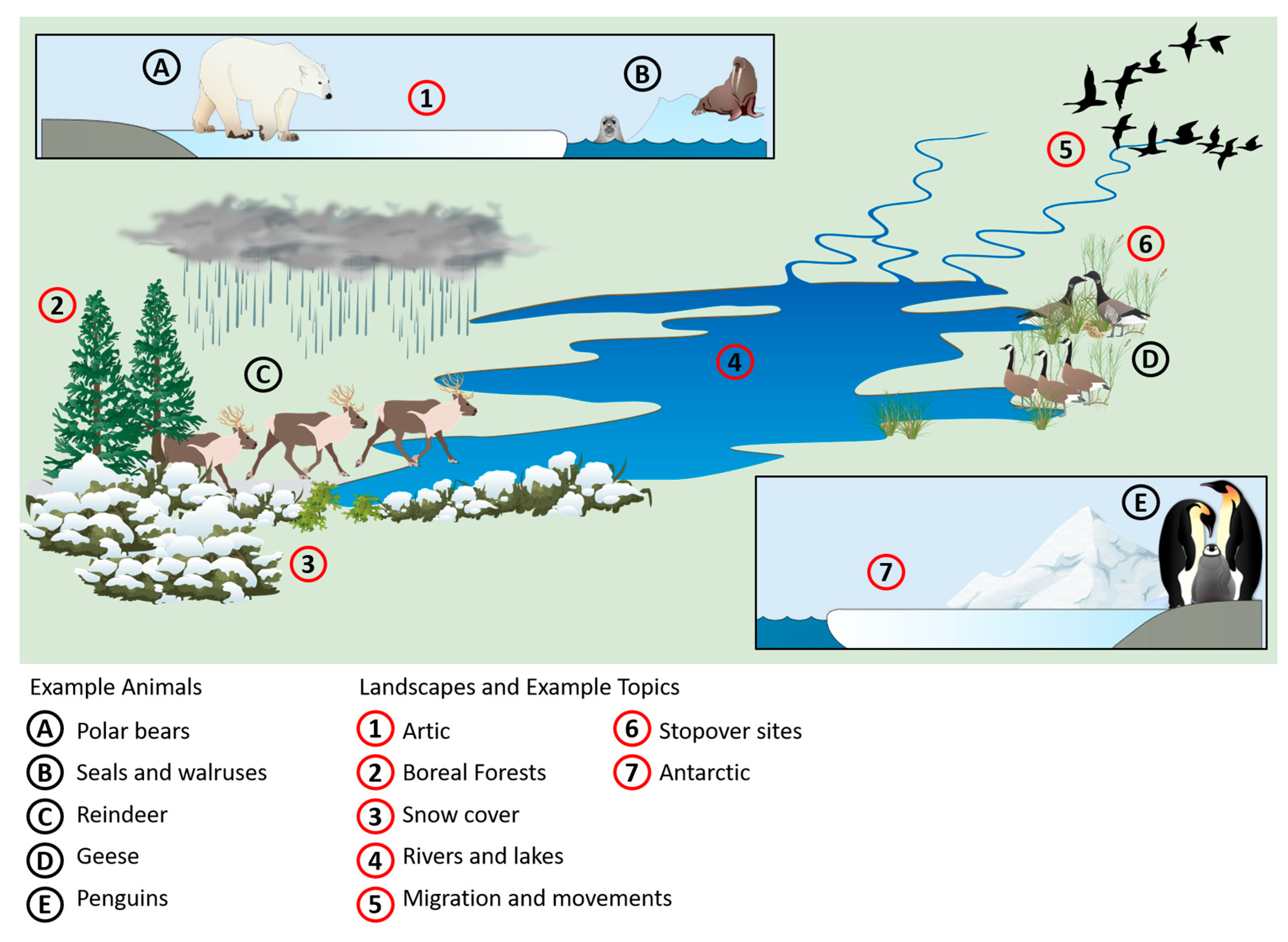
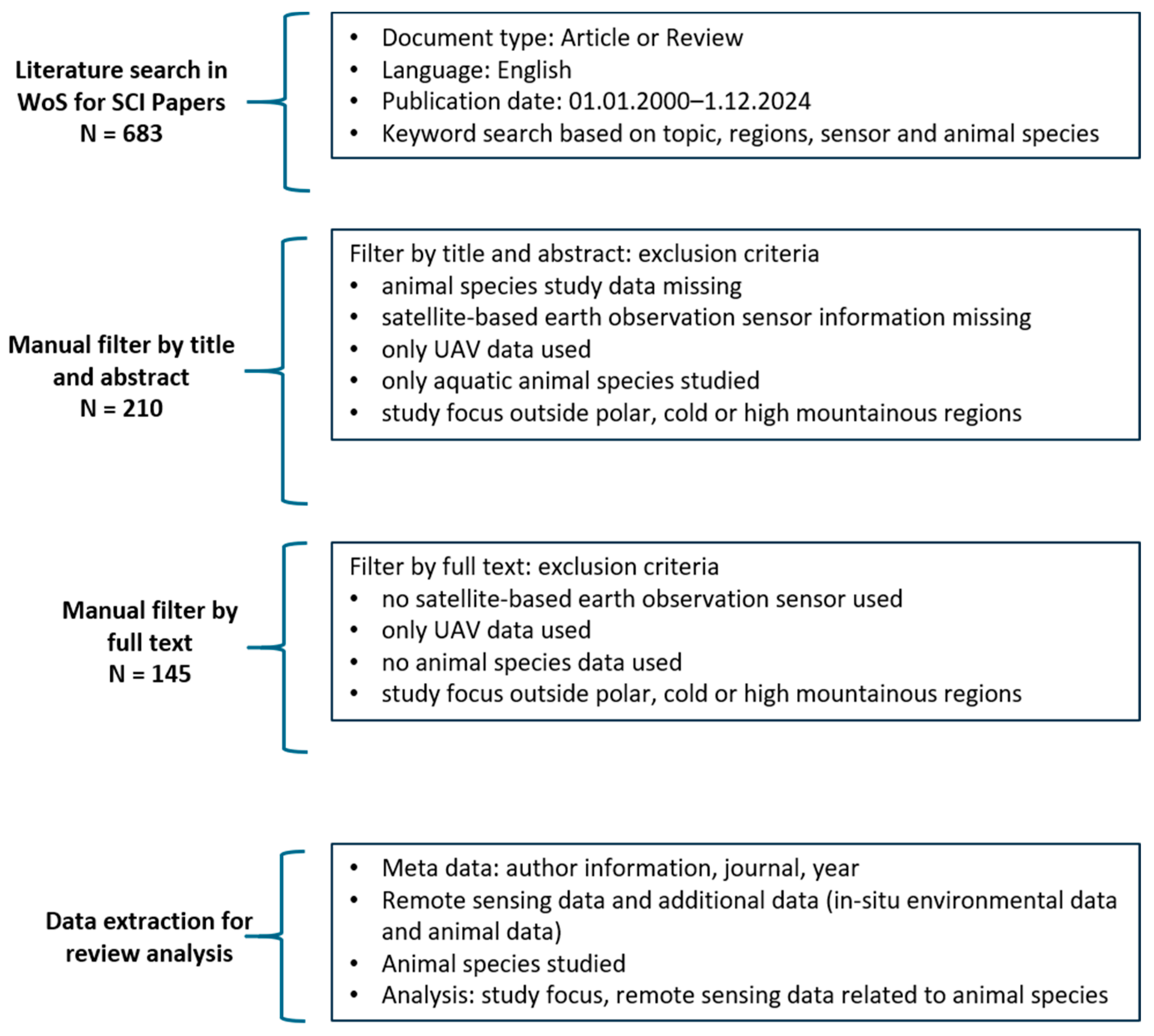
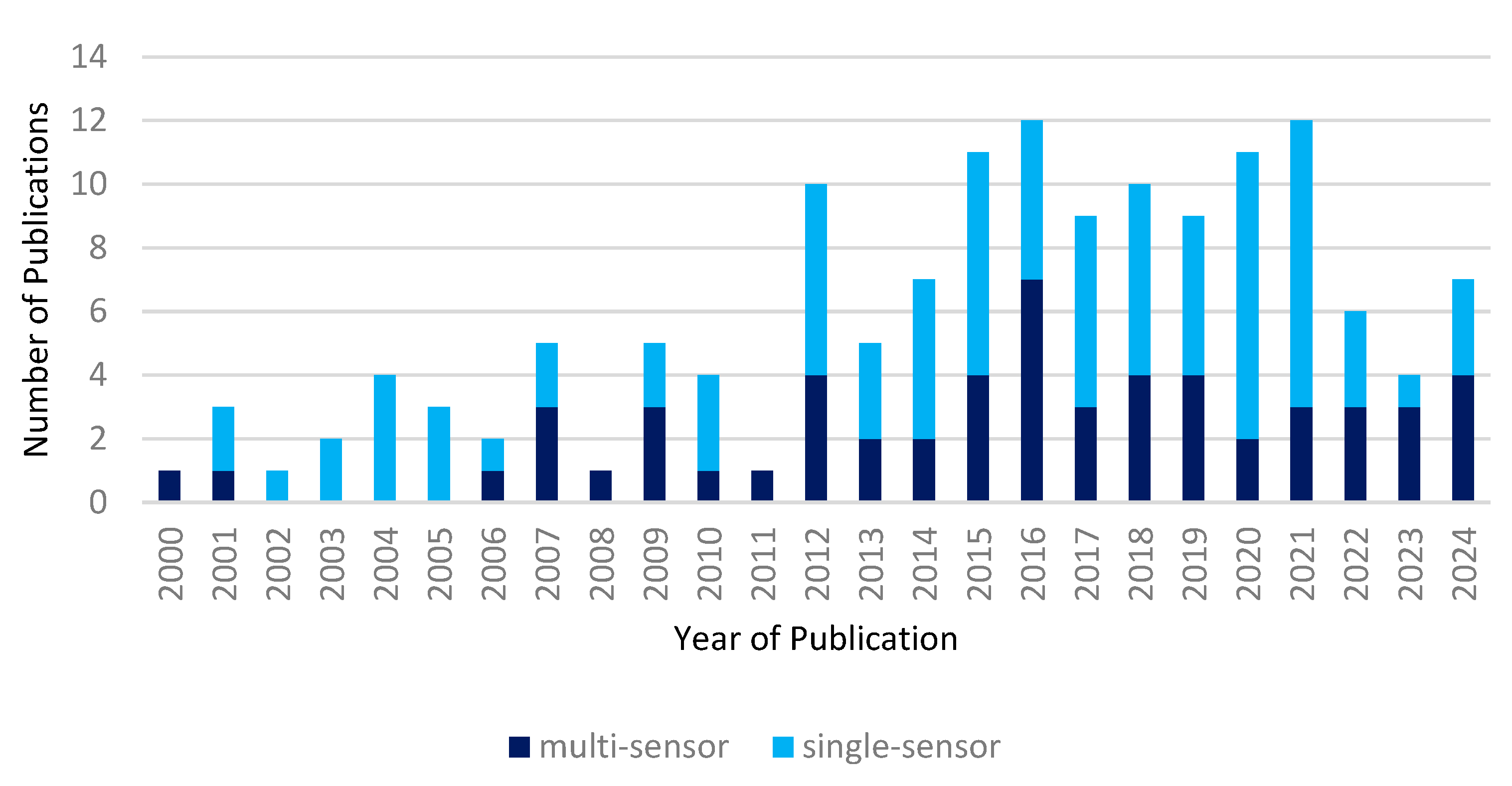
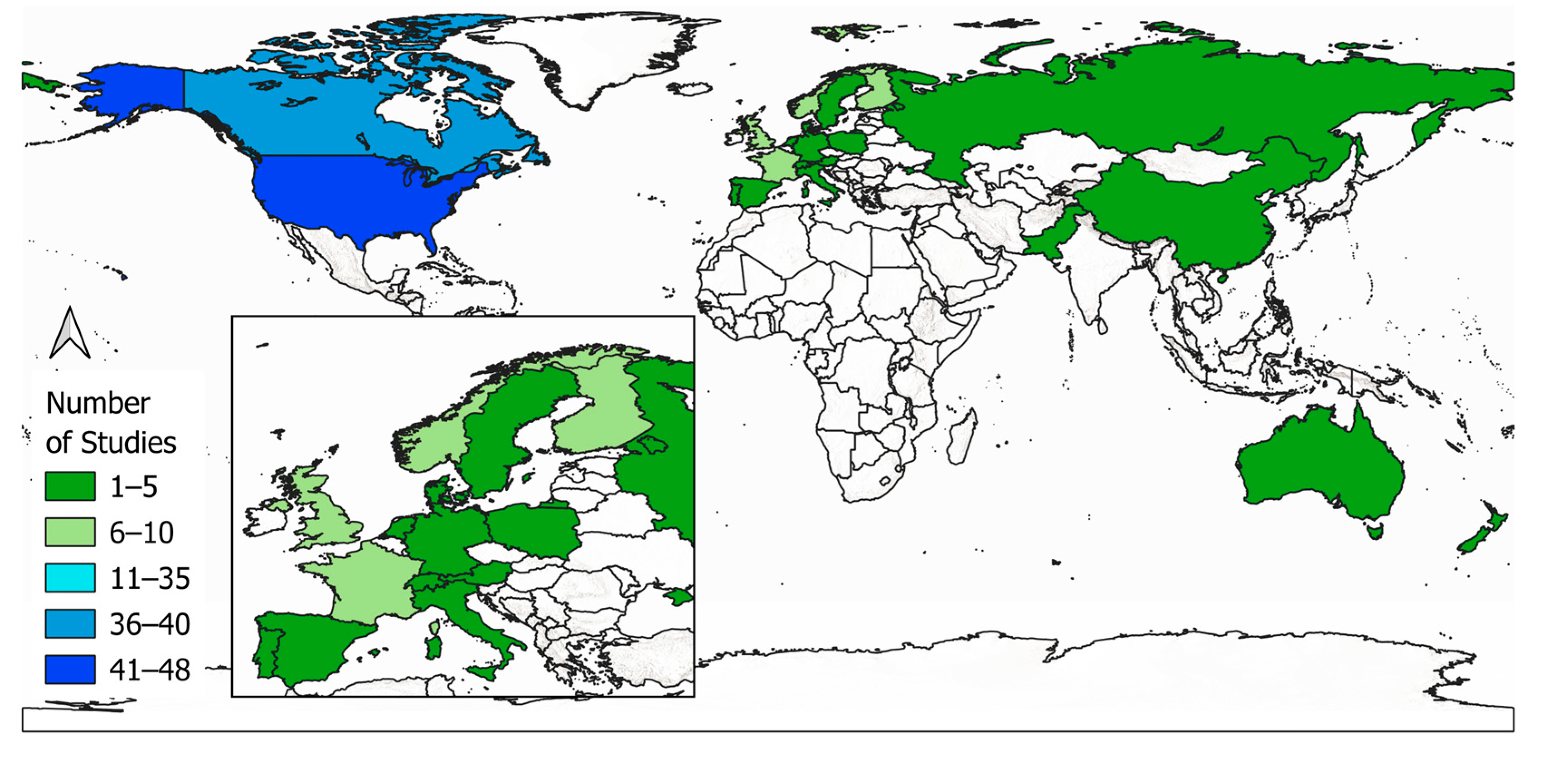
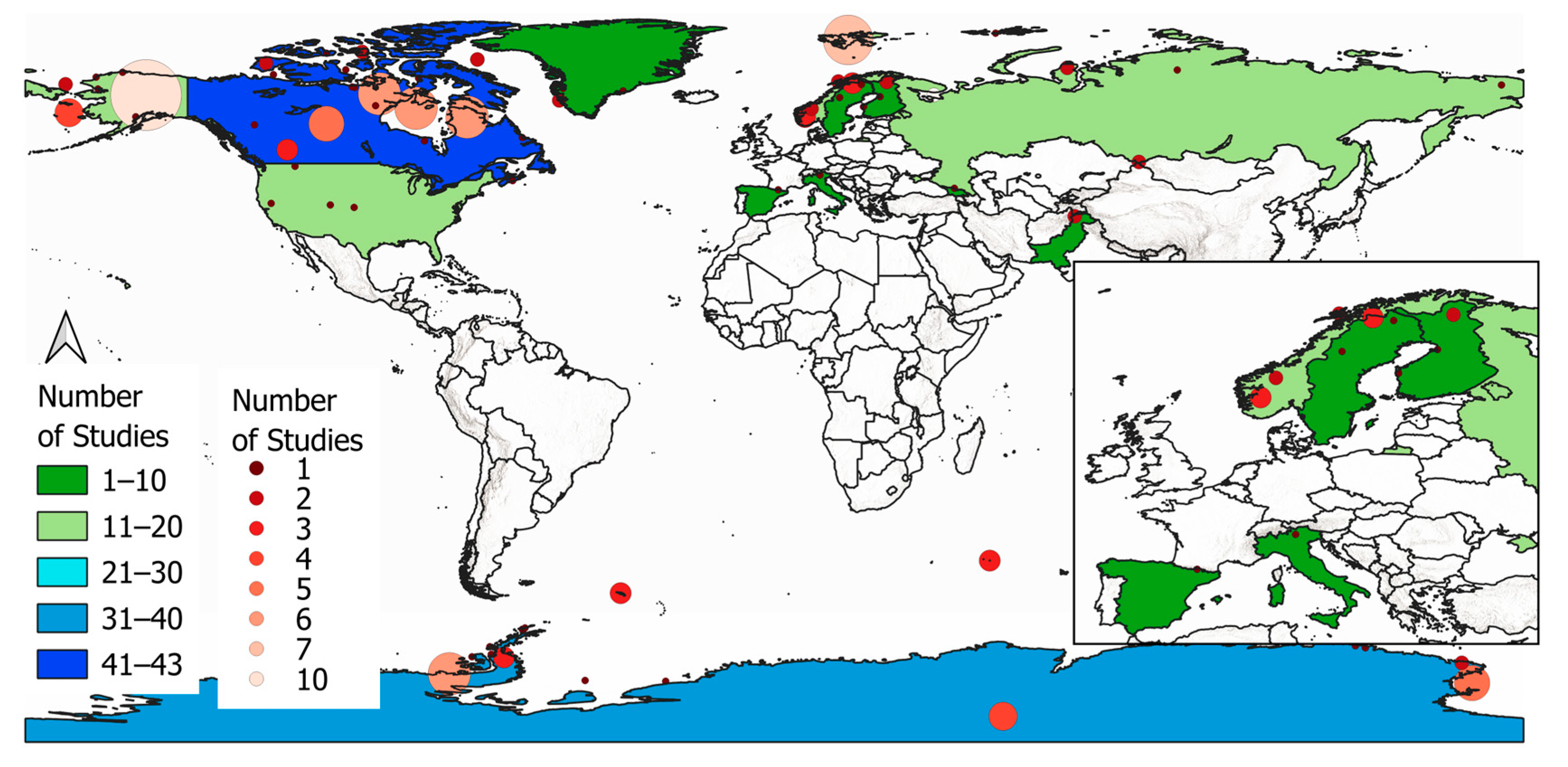
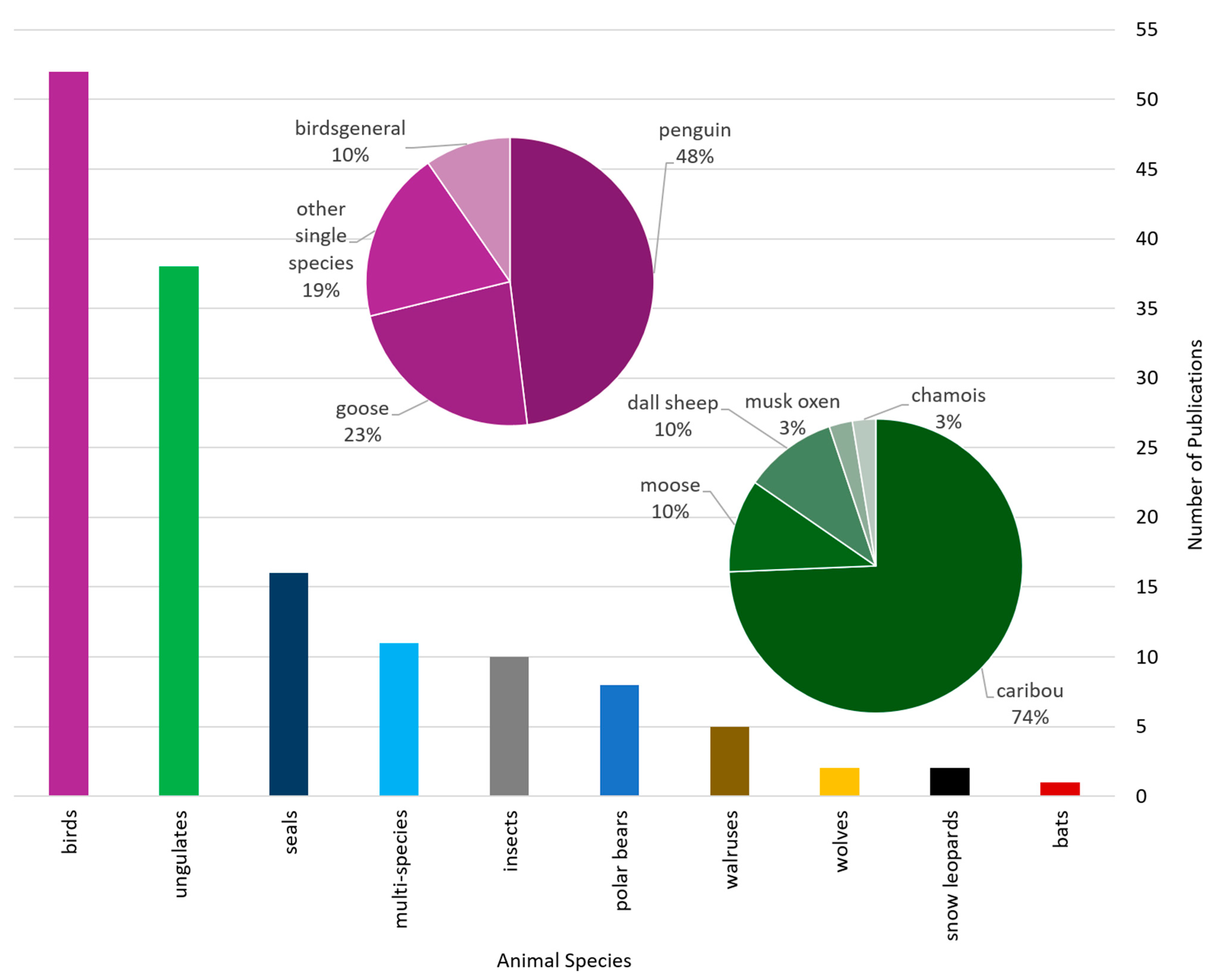
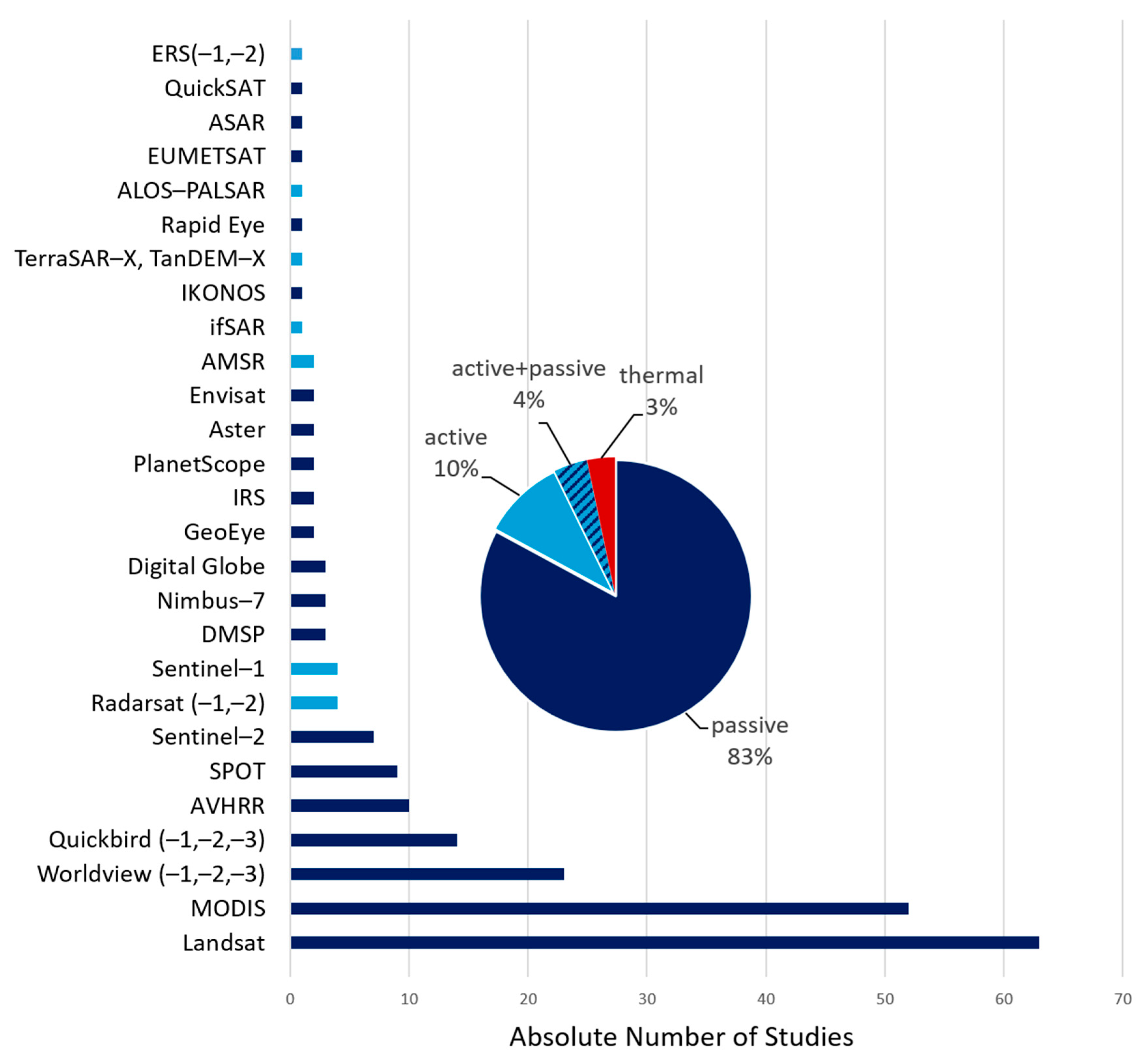
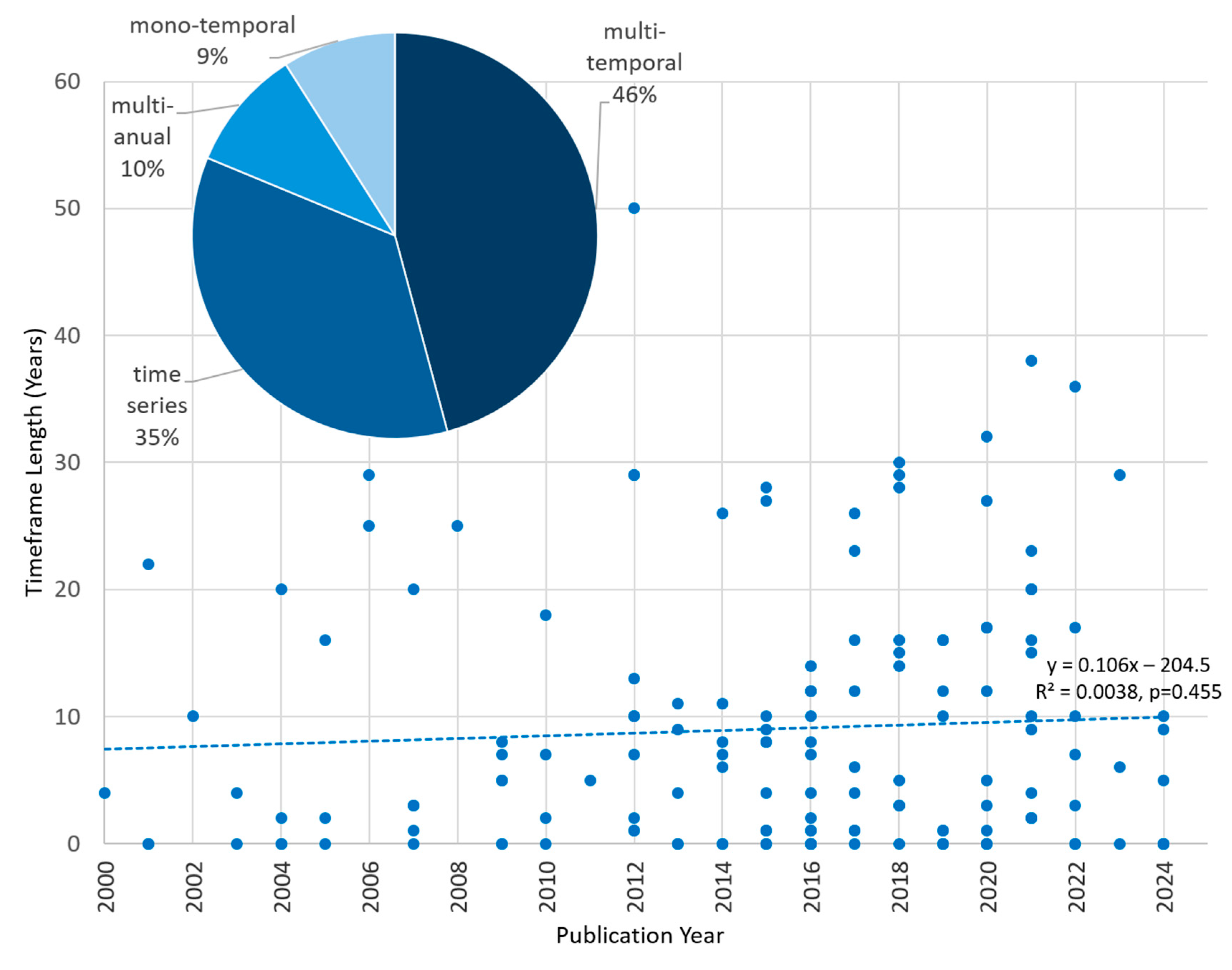
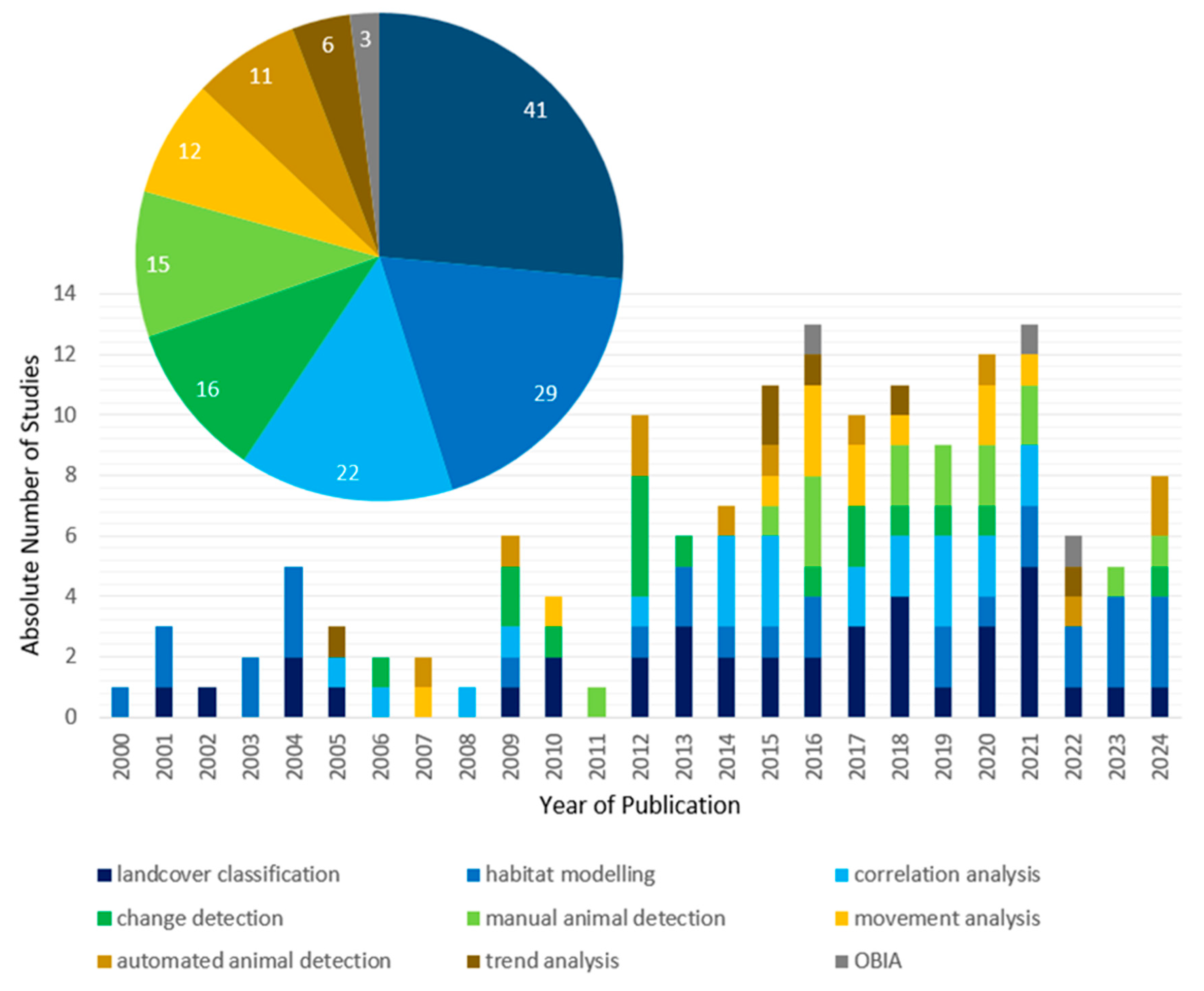
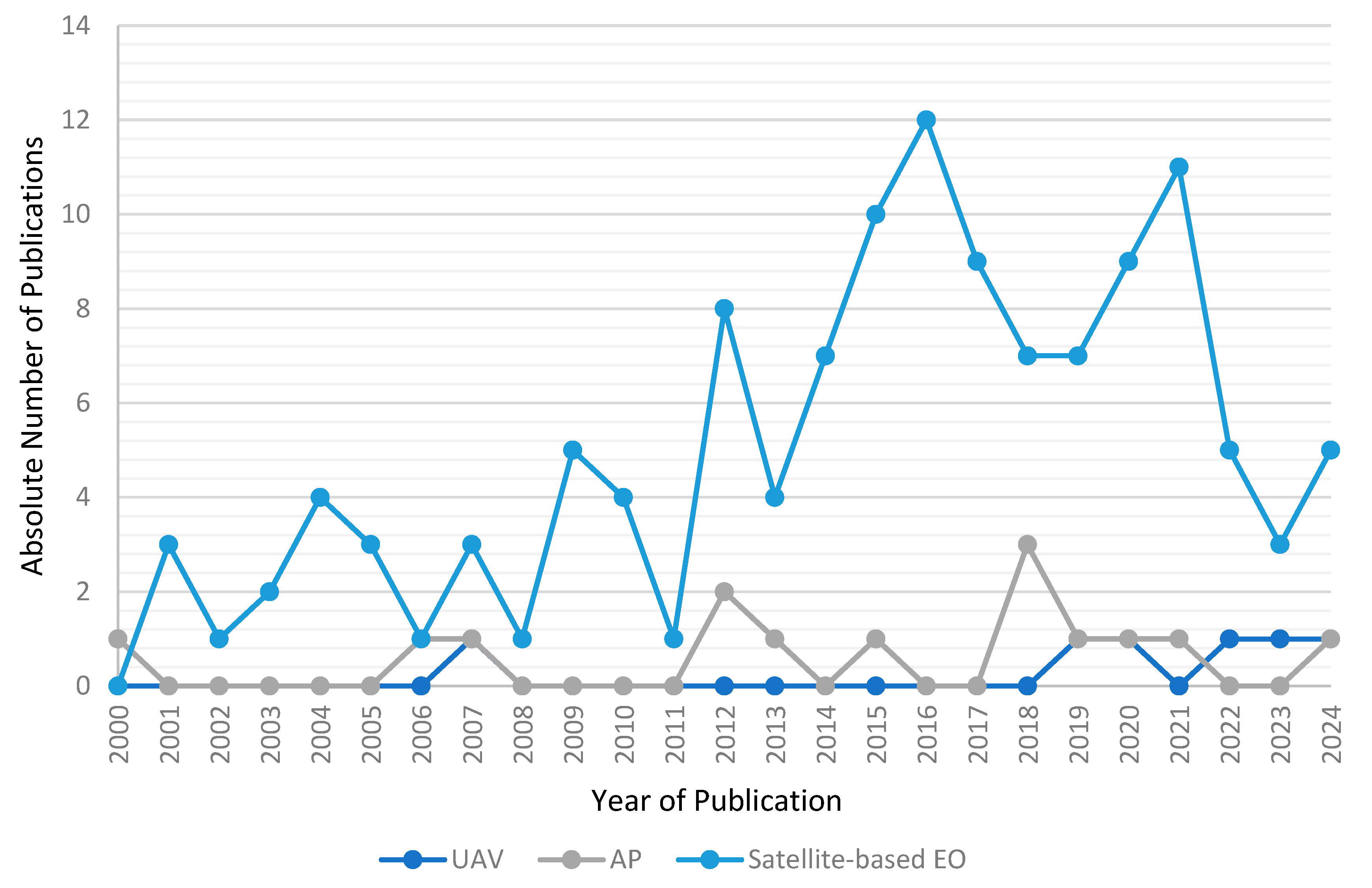


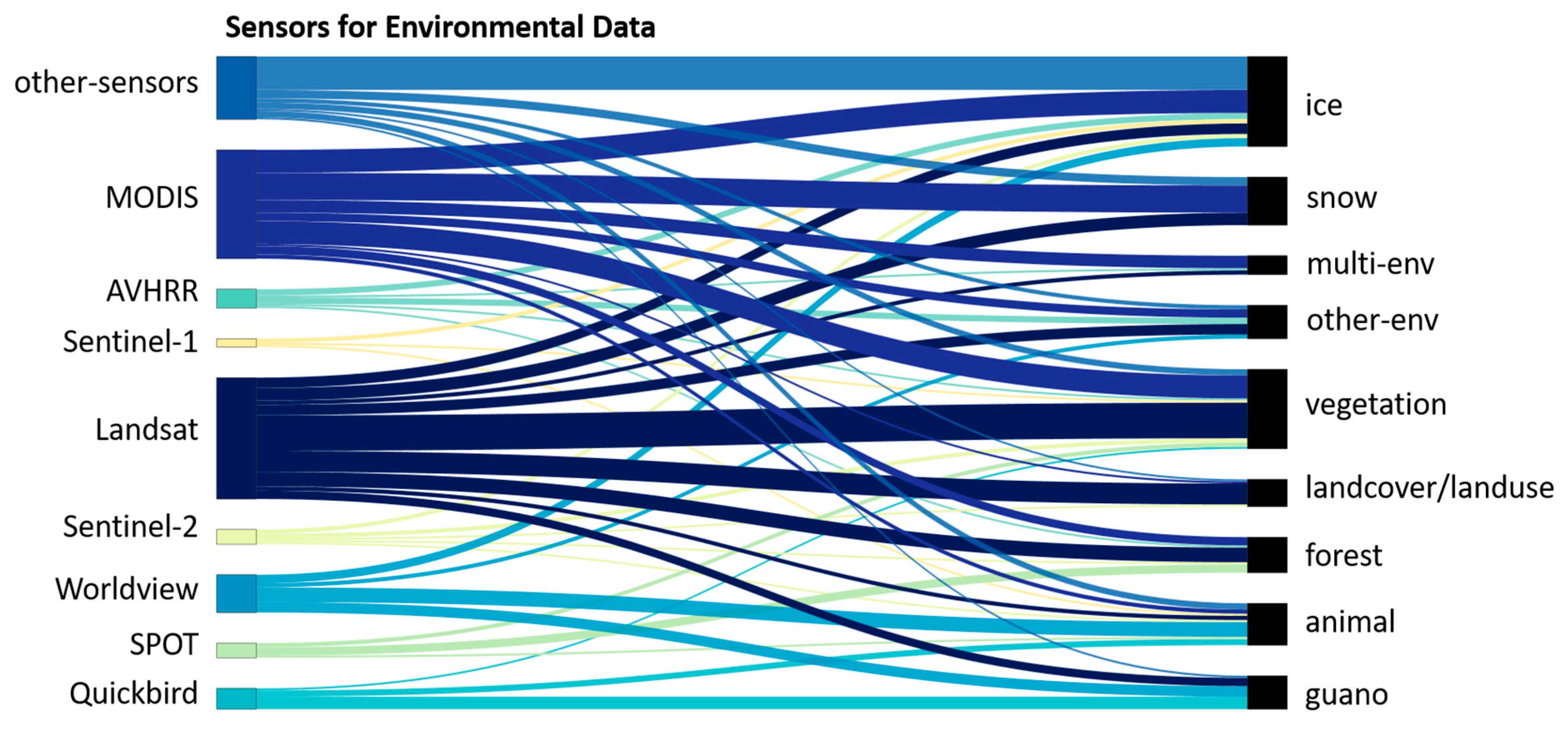

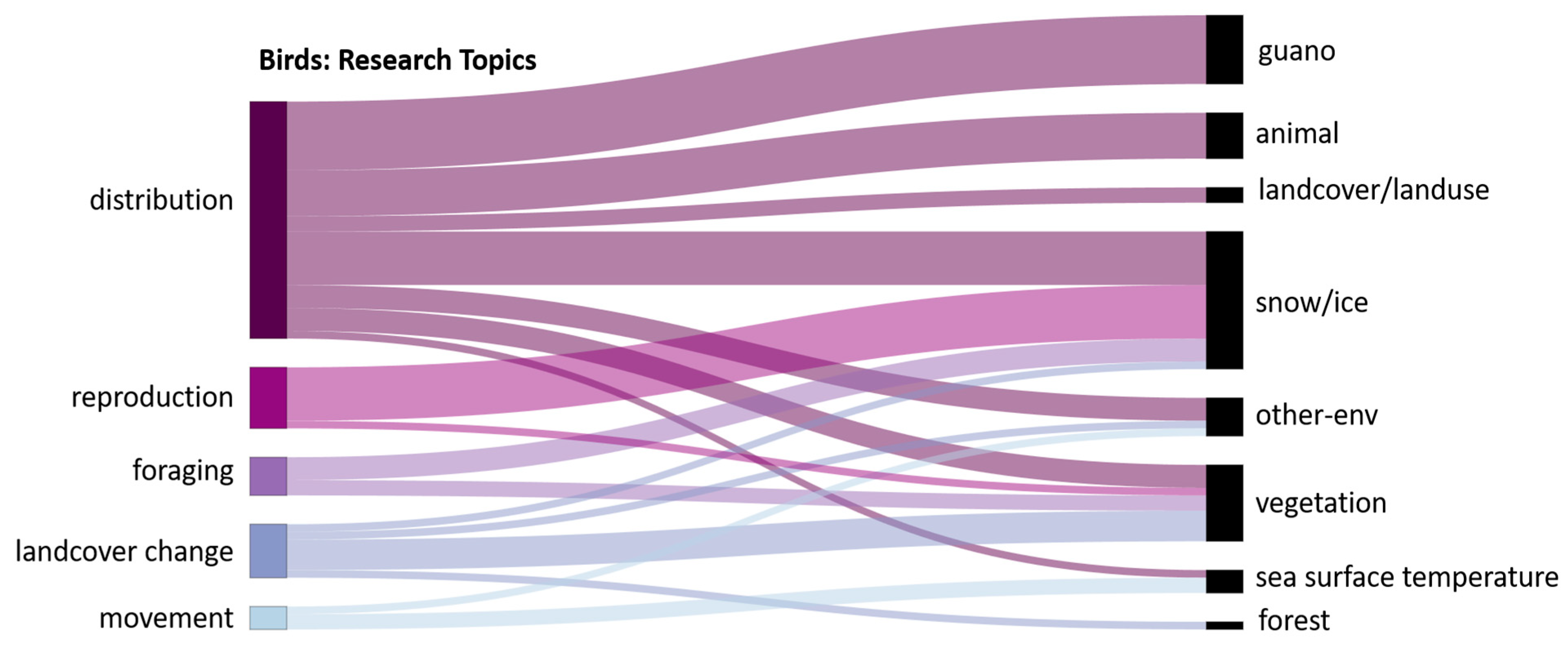
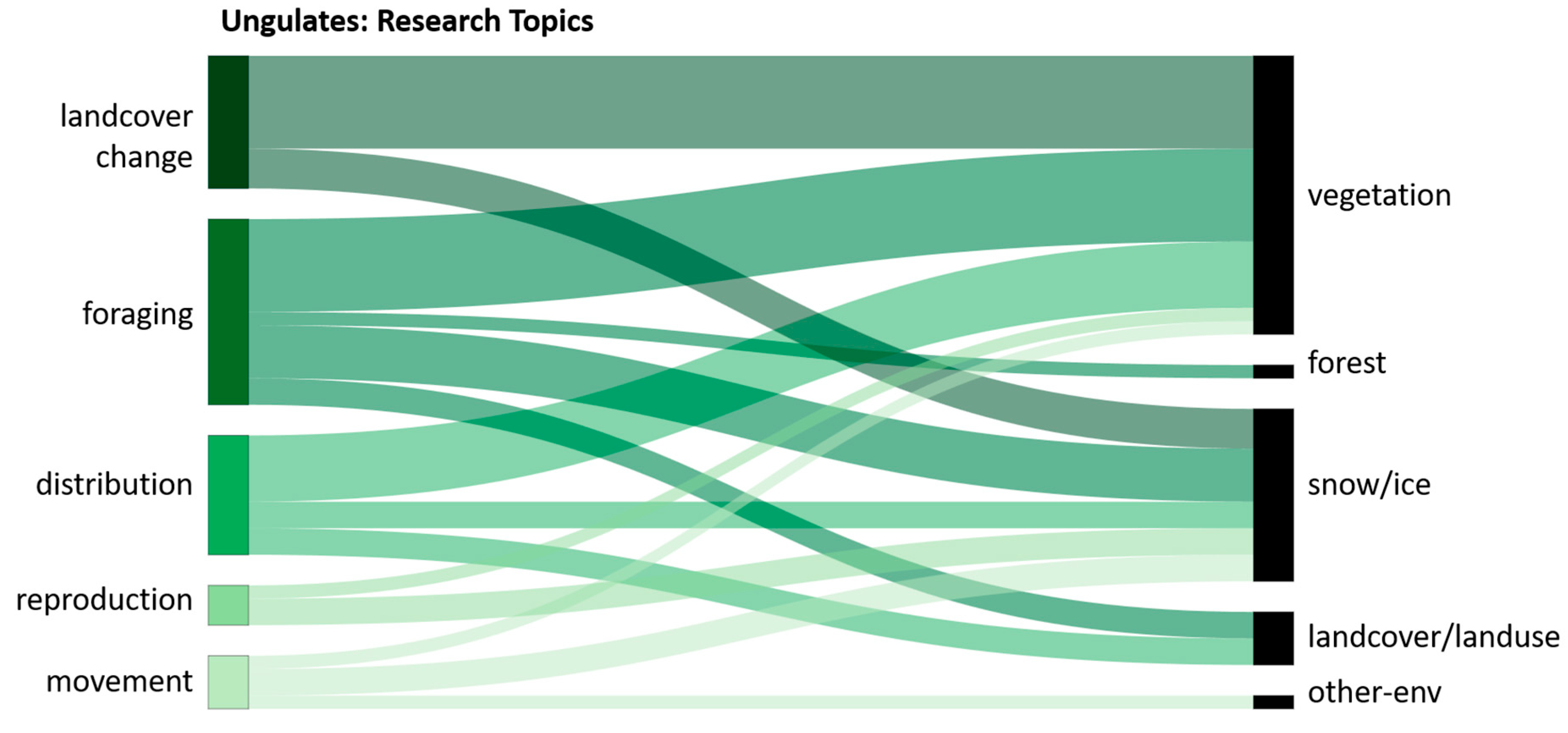
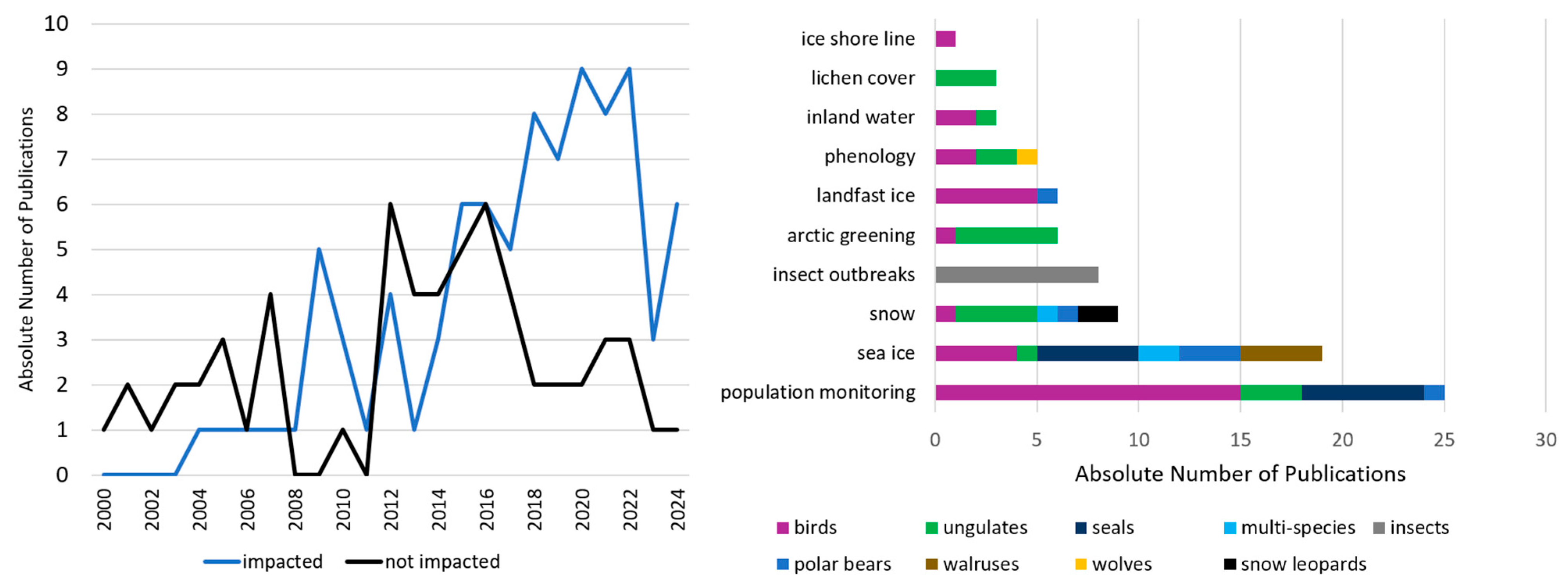
Disclaimer/Publisher’s Note: The statements, opinions and data contained in all publications are solely those of the individual author(s) and contributor(s) and not of MDPI and/or the editor(s). MDPI and/or the editor(s) disclaim responsibility for any injury to people or property resulting from any ideas, methods, instructions or products referred to in the content. |
© 2025 by the authors. Licensee MDPI, Basel, Switzerland. This article is an open access article distributed under the terms and conditions of the Creative Commons Attribution (CC BY) license (https://creativecommons.org/licenses/by/4.0/).
Share and Cite
Wehner, H.; Dietz, A.; Kounev, S.; Kuenzer, C. Systematic Review of Satellite-Based Earth Observation Applications for Wildlife Ecology Research in Terrestrial Polar and Mountain Regions. Remote Sens. 2025, 17, 2780. https://doi.org/10.3390/rs17162780
Wehner H, Dietz A, Kounev S, Kuenzer C. Systematic Review of Satellite-Based Earth Observation Applications for Wildlife Ecology Research in Terrestrial Polar and Mountain Regions. Remote Sensing. 2025; 17(16):2780. https://doi.org/10.3390/rs17162780
Chicago/Turabian StyleWehner, Helena, Andreas Dietz, Samuel Kounev, and Claudia Kuenzer. 2025. "Systematic Review of Satellite-Based Earth Observation Applications for Wildlife Ecology Research in Terrestrial Polar and Mountain Regions" Remote Sensing 17, no. 16: 2780. https://doi.org/10.3390/rs17162780
APA StyleWehner, H., Dietz, A., Kounev, S., & Kuenzer, C. (2025). Systematic Review of Satellite-Based Earth Observation Applications for Wildlife Ecology Research in Terrestrial Polar and Mountain Regions. Remote Sensing, 17(16), 2780. https://doi.org/10.3390/rs17162780




